The very name Mecklenburg-Vorpommern has fascinated me since childhood, although I had no clue what it was like. Finally, in summer 2018 I unraveled my life-long phantasies. This is what I learned: Everything is close to the water, in the north it is the Baltic Sea, further south about 2000 lakes, large and small are scattered throughout the wide land. During the train ride from Berlin to Stralsund I passed through places like Altenpretow that sounded so Prussian that my excitement grew by the minute. During my two weeks I explored Stralsund, a former Hanseatic hub, sunny Rügen, Germany largest island, and car-free Hiddensee.
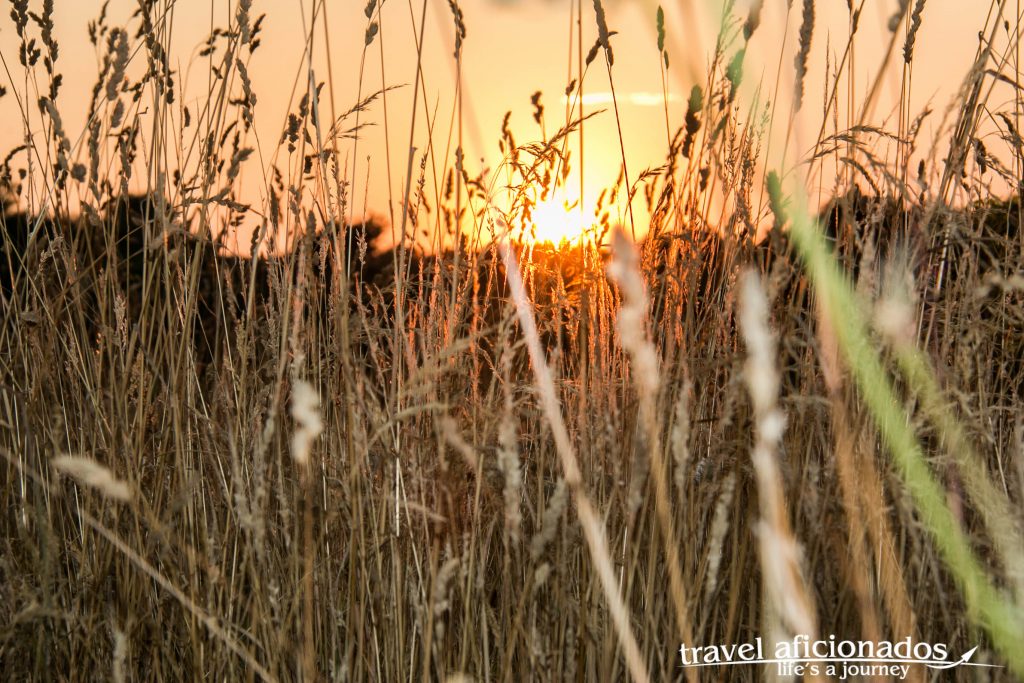
Cornfields in Mecklenburg-Vorpommern
Stralsund – Gateway to Rügen
The historic center of this Hanseatic town is plastered with impressive red-brick Gothic landmarks, like the 13th-century Town Hall. I wandered around Stralsund day and night, marveling at the mélange of beautifully restored houses with steepled roofs, old city walls and its ancient harbor. For centuries this city has witnessed trade-ships arriving and leaving, but also violent struggles like the counterreformation. Such magnificence and remarkable past attract tourists from all parts of Germany especially those on their way to the Rügen Island, like me.
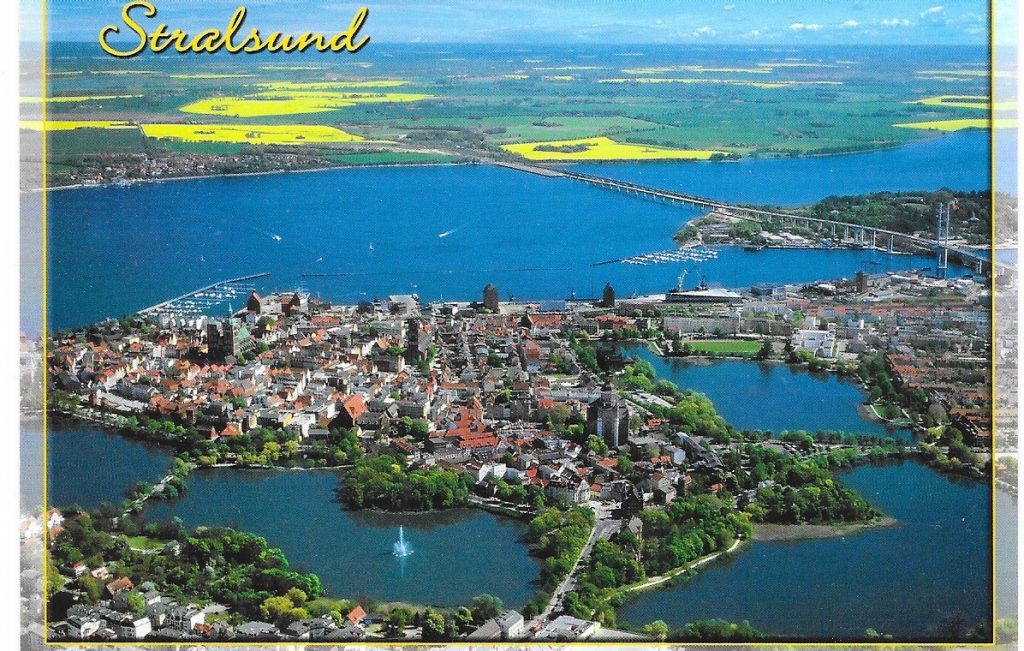
Stralsund – Hanseatic Town – Gateaway to Rügen
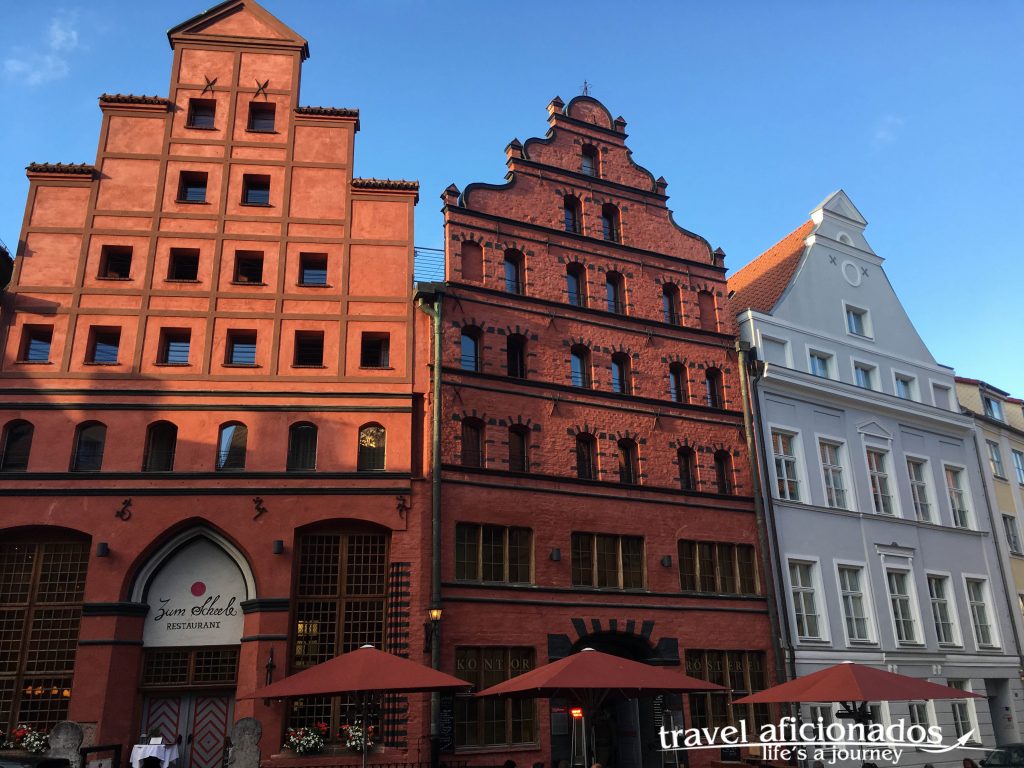
Stralsund – historic center
Stralsund – history crash course
Being a history nerd, I joined a historic city walk with a local, on my very first day. Naturally I did not forget the date when Stralsund was founded, 1234, who would? Stralsund was the hub of an once extensive trade route. This is still reflected in its architecture. The goods traded were stored behind the decorative steepled facade of longish warehouses. Smaller buildings were attached to the backwall of the warehouse, those were the living quarters of the traders. Also in the port, large warehouses tell the story of cereal arriving from Mecklenburg or precious commodities like salt from Lübeck, to preserve the herring around Stralsund.
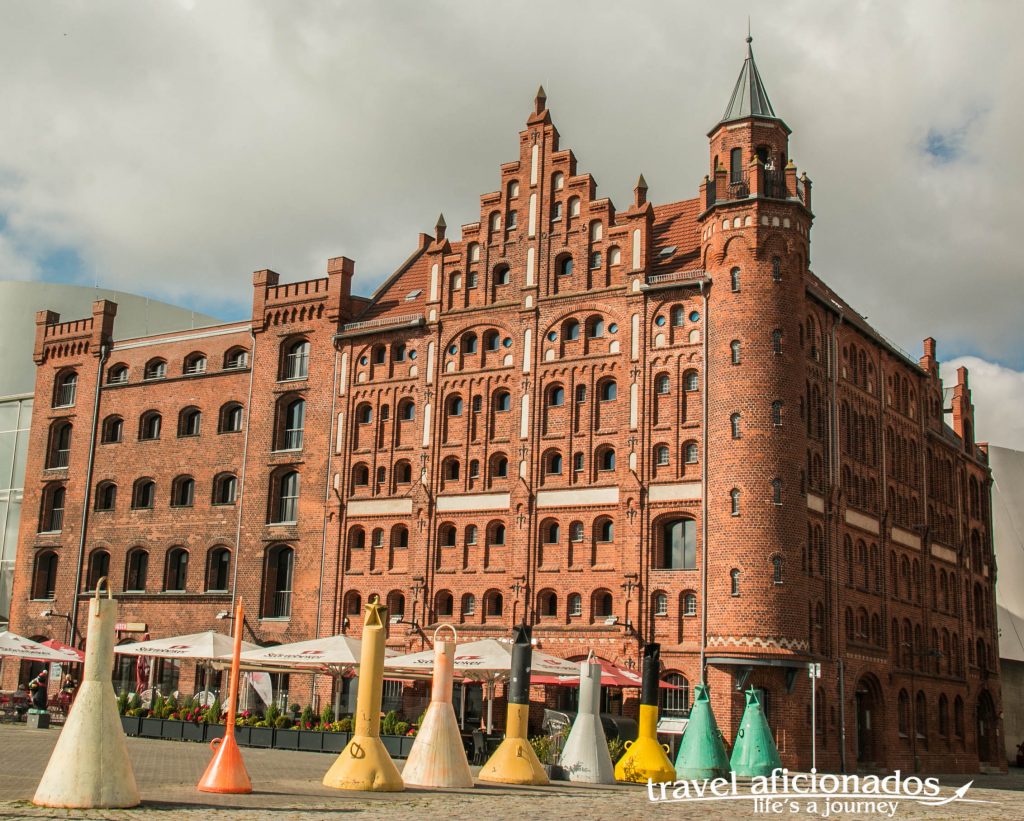
Stralsund historic center, harbour
A crucial historic period was the siege through Wallenstein’s troops during the 30 Years War. But Stralsund remained the Protestant stronghold it had been since Luther’s days and the city was spared the Catholic Counter-reformation. What helped to defend the town were its insular location, the strong fortifications and the support of Swedish troops. The price: Swedish rulership for about 200 years.
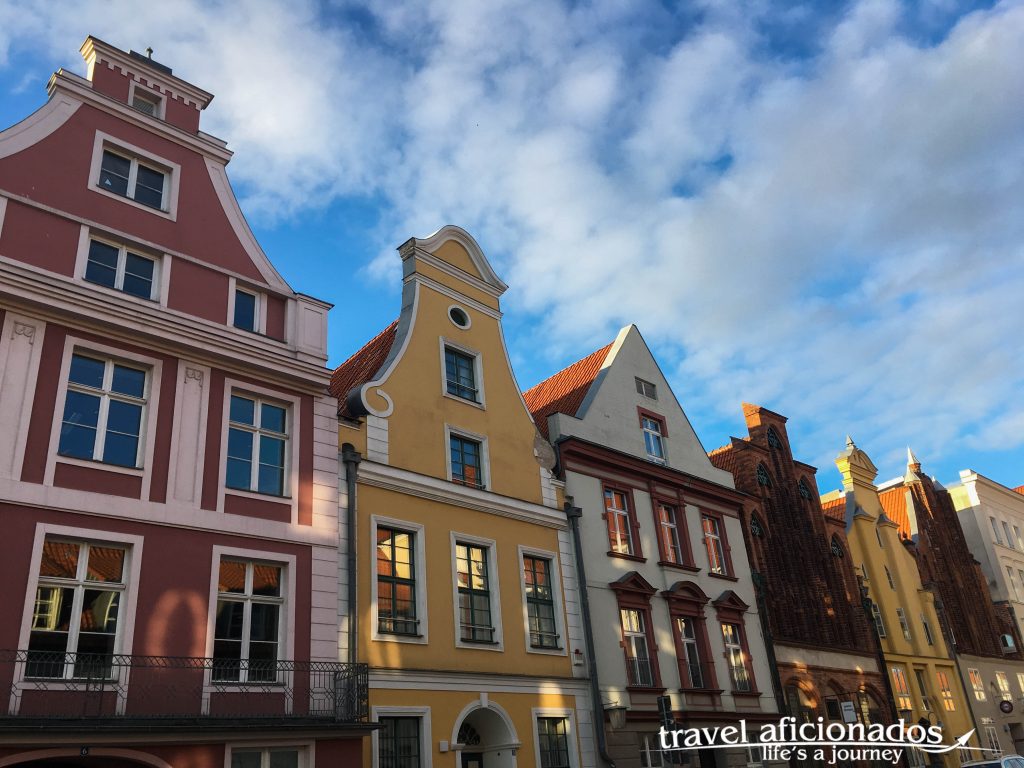
Stralsund – historic center
At the end of the 19th century most of the 3,5km long city wall was torn down, together with the 10 gates. They had become bottlenecks for the traffic in and out of the city. Nowadays only parts of the old city wall and a few gates are left. Picturesque Stralsund has not always looked so picturesque. In World Word II parts of the historic center were destroyed in bomb raids. Photos taken in the 1980s show that even then, some of the houses were in a terrible condition. Only after the „Wende“ renovation of the steepled houses began and this trend picked up speed when the city was granted UNESCO World Heritage Status in 2002.
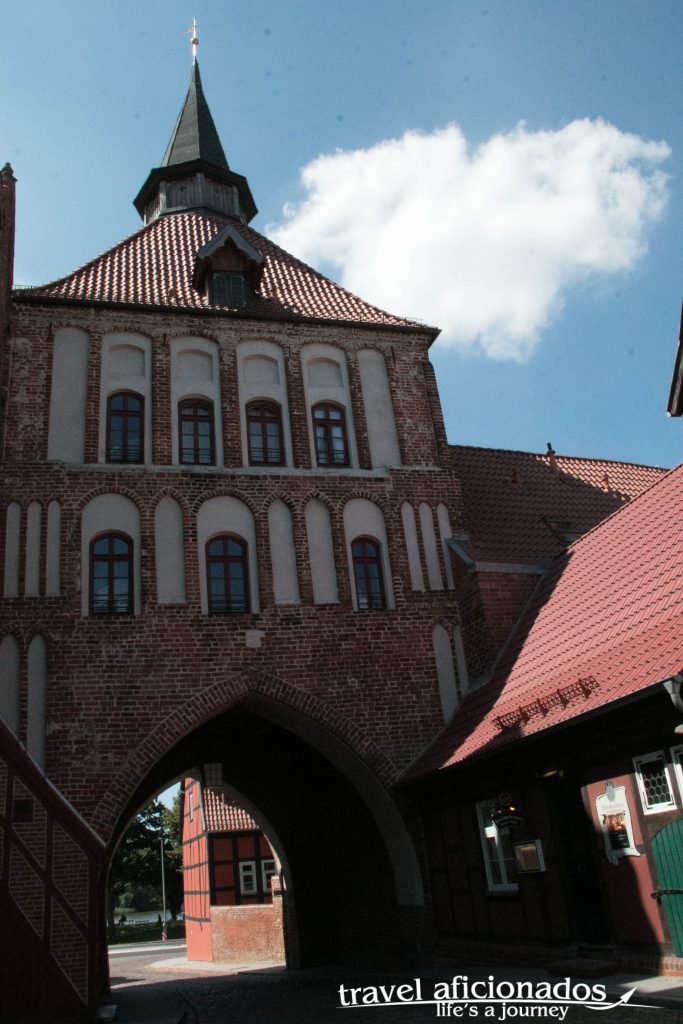
One of the few remaining city gates
Sight-Seeing Stralsund
My extensive walks through old Stralsund always brought me back to its magnificent main square, with Stralsund oldest church St. Nicolai Church and its 13th century City Hall. You are also never far from the water, basically Stralsund is an island. I skipped Stralsund’s pride, the gigantic Oceanium, since €17 seemed too steep to learn about wildlife in northern oceans. A real great experience was the view from the bell tower of Marienkirche – a true pay-off for all the puffing and struggling up the 365 steps.
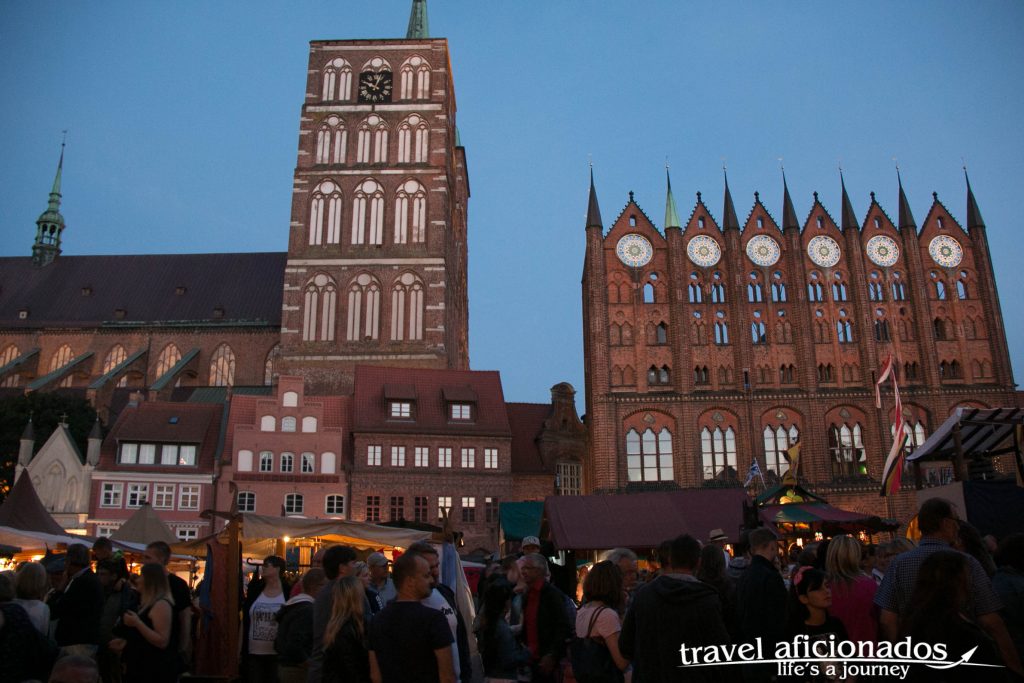
Stralsund St-Nicolai Church and City Hall
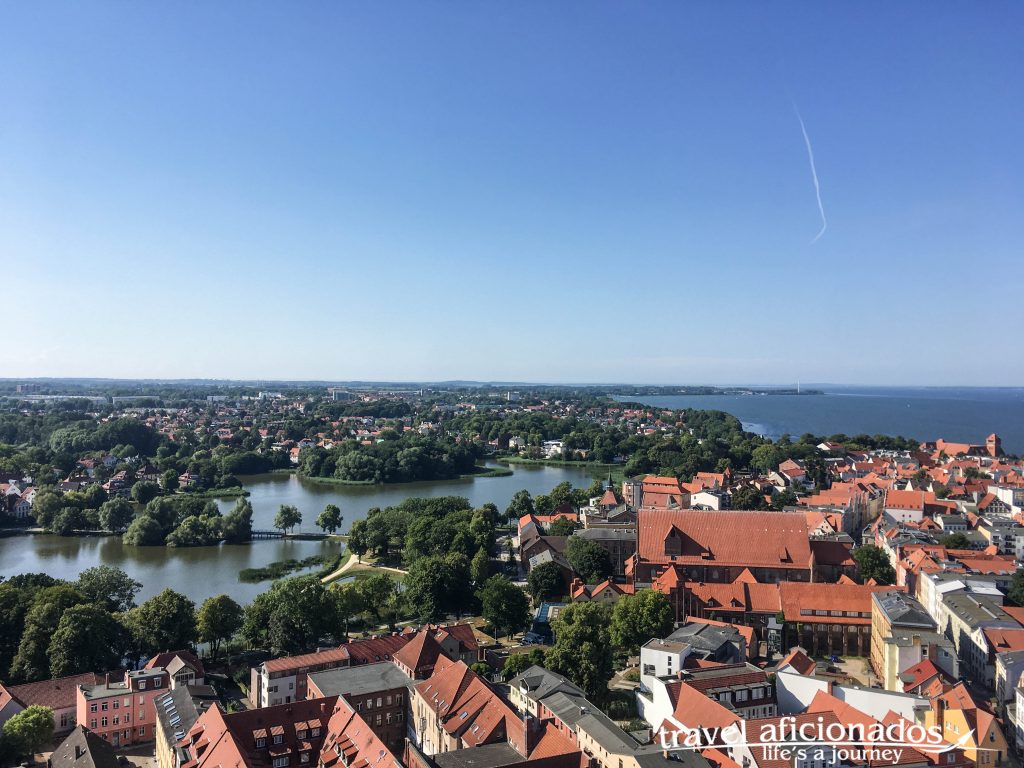
Stralsund from the top of Marienkirche
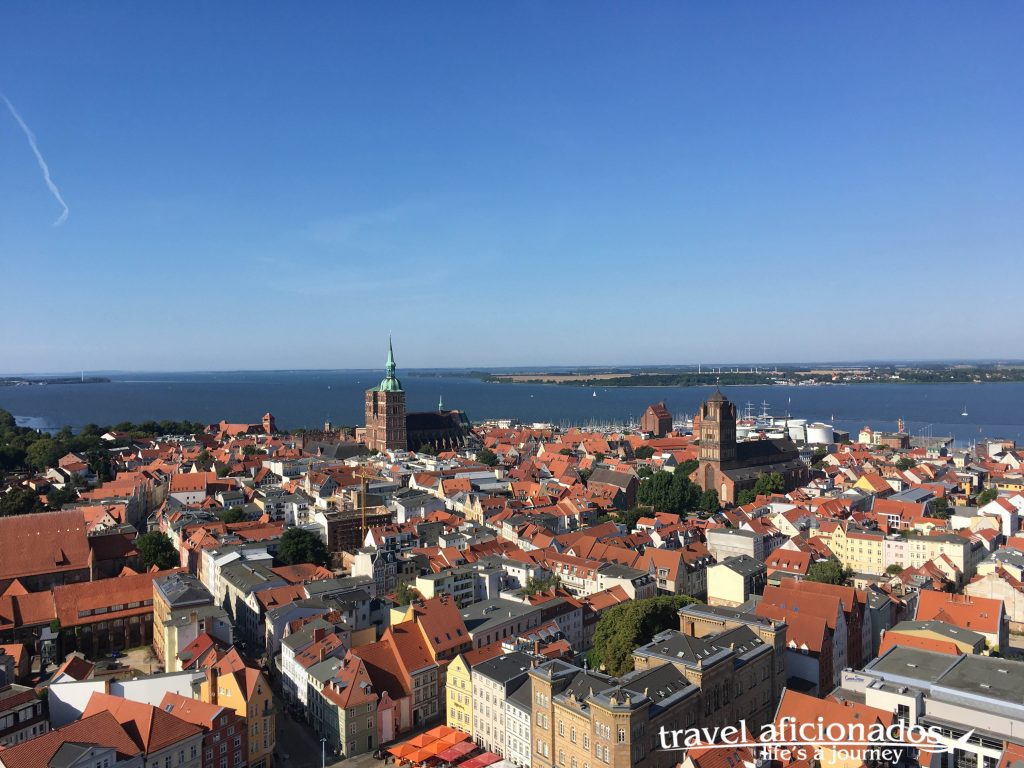
Stralsund from the top of Marienkirche
Lucky me I was in town for at least one day of the “Wallensteintage”. This annual four day event is staged to remind of Wallenstein’s futile attempts to recapture Stralsund. During these four days, Stralsund turns into a party and event zone. The battles against Wallenstein are re-enacted, as well as a 17th century marketplace with artists and fire-eaters. Soldiers in historic uniforms set up camp outside town and historic weaponry is on display. Also locals walk around in historic costumes and love to have their photos taken. A really gory spectacle was a small night-time procession re-enacting how victims of the plague were removed from the town. In 1629 this disease killed a large number of the town people. On my way back to hotel I passed the harbor area where a temporary amusement park was set up. Watching the merry-go-round moving BACKWARDS super-fast and listening to the people screaming made me almost vomit.
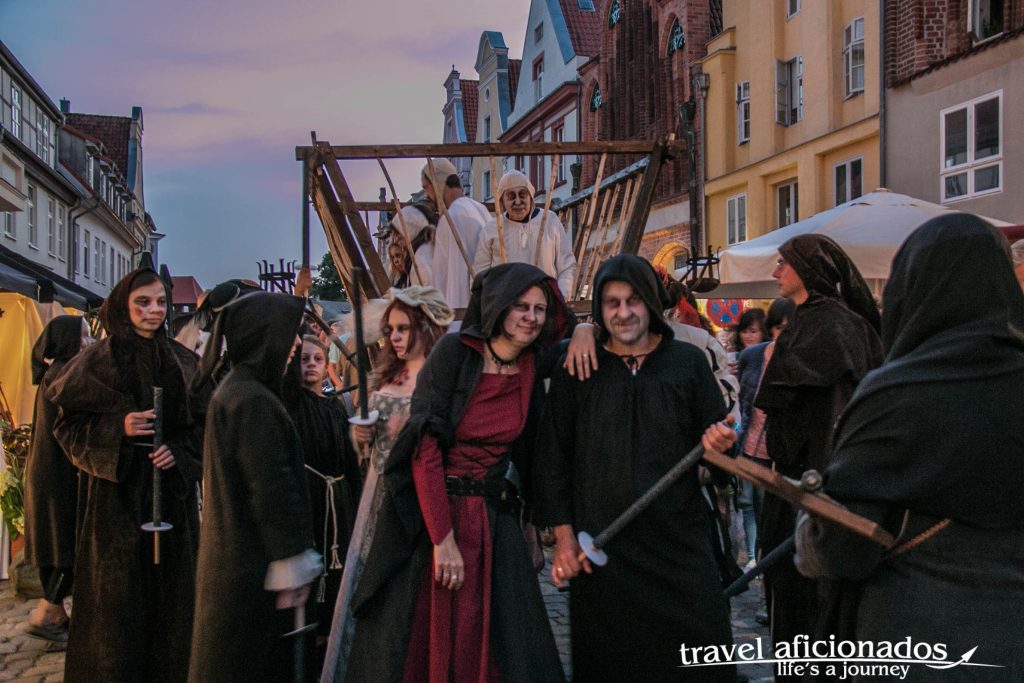
Wallensteintage – four day festival that reminds of historic events, like the attacks of Wallenstein’s troops or the plague
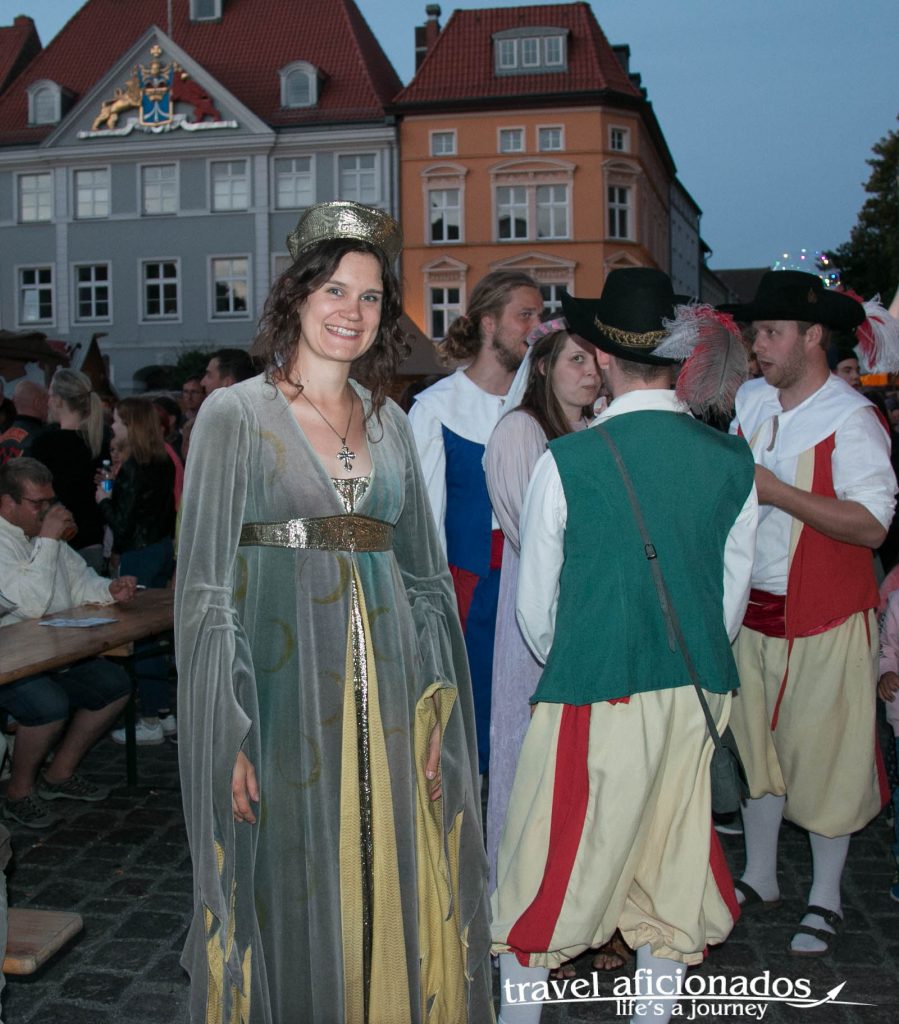
Wallensteintage – locals dress up in historical costumes
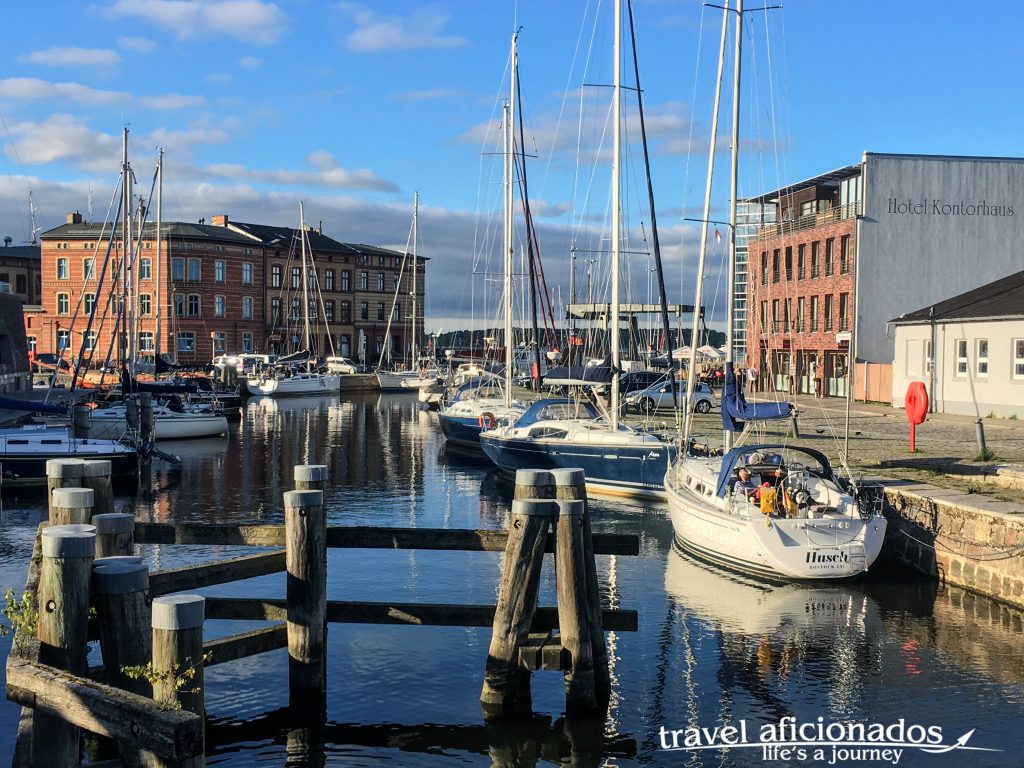
Stralsund – harbour area
Accommodation+Food:
I strongly recommend to stay at Haus Wullfcrona in the very city center, with great cozy rooms, an excellent breakfast buffet and a fairly large quiet garden. Since I travelled alone I did not spend lots of money on fancy dinners, but returned to my favorite Hafenkneipe, “Die Fähre”, where I got a bite to eat and had a chance to mingle with people.
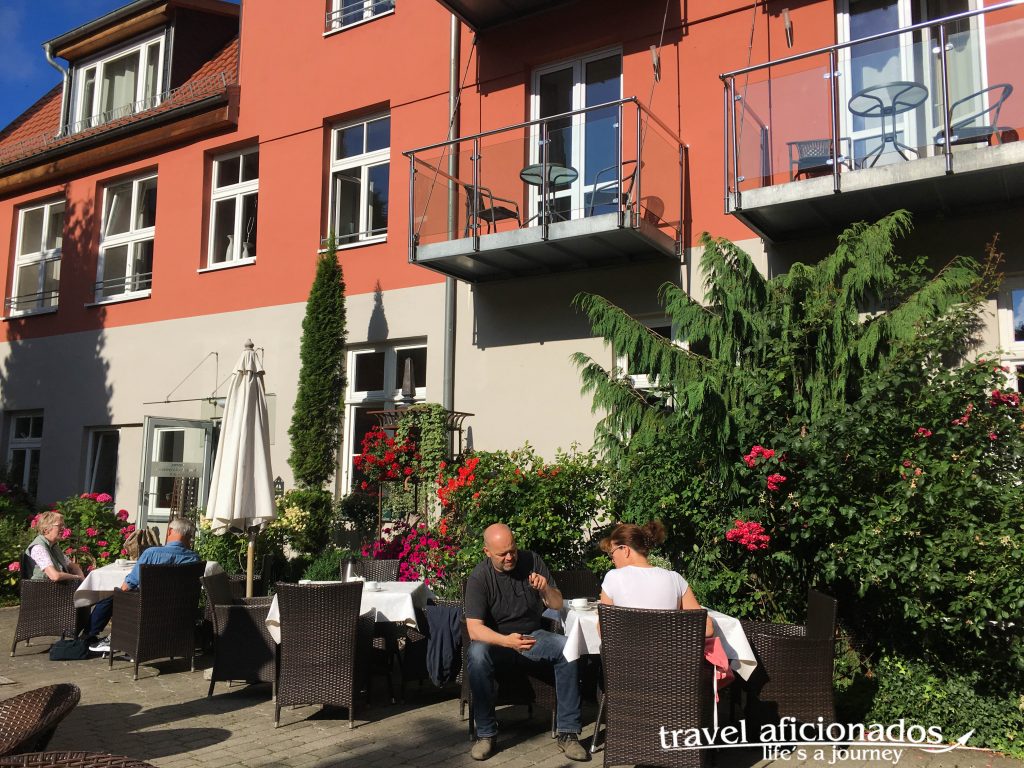
Breakfast at Hotel Wullfcrona Garden

Zur Fähre – a true Hafenkneipe, my wateringhole while in Stralsund
Rügen Island – the bathtub of Berliners
From Stalsund the 4097m long bridge crosses over to Rügen, Germany’s largest island, but I took the ferry to Binz, where I settled down for a week. No town or village on the island is more than 7 kilometres away from the coast. The roots of Rügen’s tourism go back to the early 19th century, no surprise being only a three hour train ride away from Berlin.
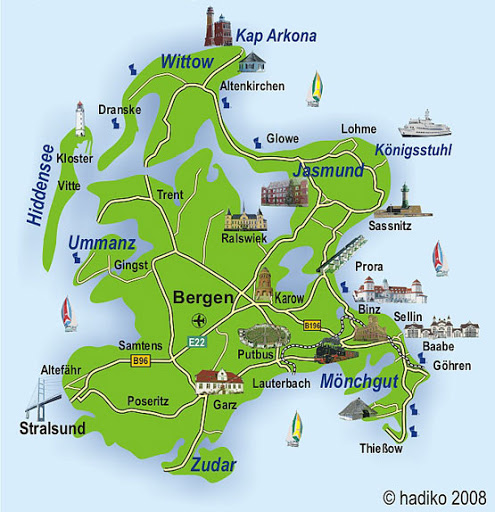
Map of Rügen
I immediately studied the brochure of the local tourist board and discovered Rügen offers a different activity for every single hour of the day. I biked to Sassnitz and Prora, the former NS resort and took boats trips to Jasmund National Park with its White Cliffs and other scenic places. To get a good view of the island I climbed the 30m high tower of Baumwipfelsteig that overlooks the Bodden of Jasmund, Prora, Binz and on a clear day you can see the bell towers of Stralsund.
Around 2,000 hours of sunshine per year make Rügen and Hiddensee two of the sunniest regions of Germany and a very busy holiday destination.
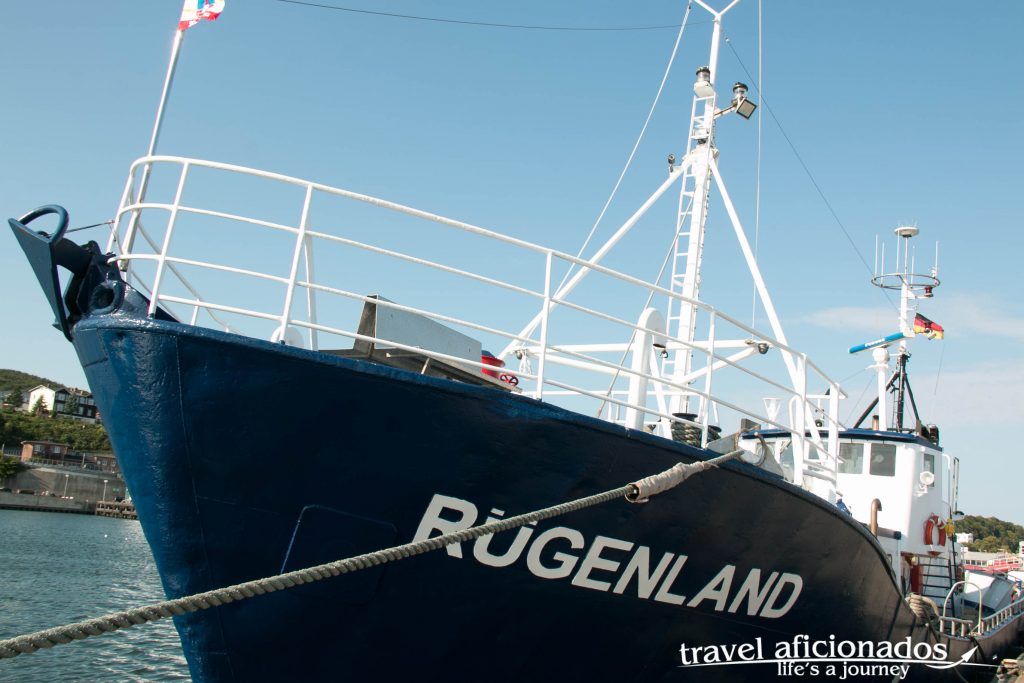
Sassnitz harbour
Binz – from village to overtourism
Of course, glamorous Binz is the most popular place on the island of Rügen, and therefore NOT the place to stay during the busy summers. But I had no car, was travelling alone and the quieter place seemed to be more effort to reach and once there, in order to do little trips you had even less access to public transport. So I settled in Binz, the only room I could get was for €110 in an ocean-front hotel, full of families and elderly people, simply horrible when travelling alone.
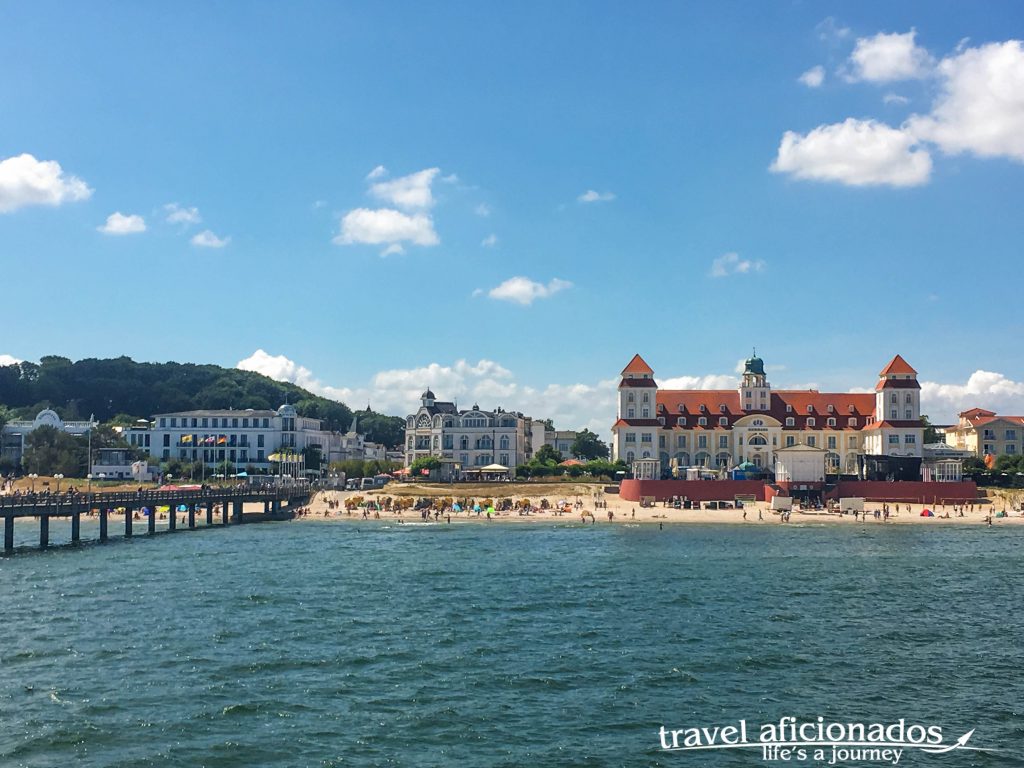
Arriving in Binz
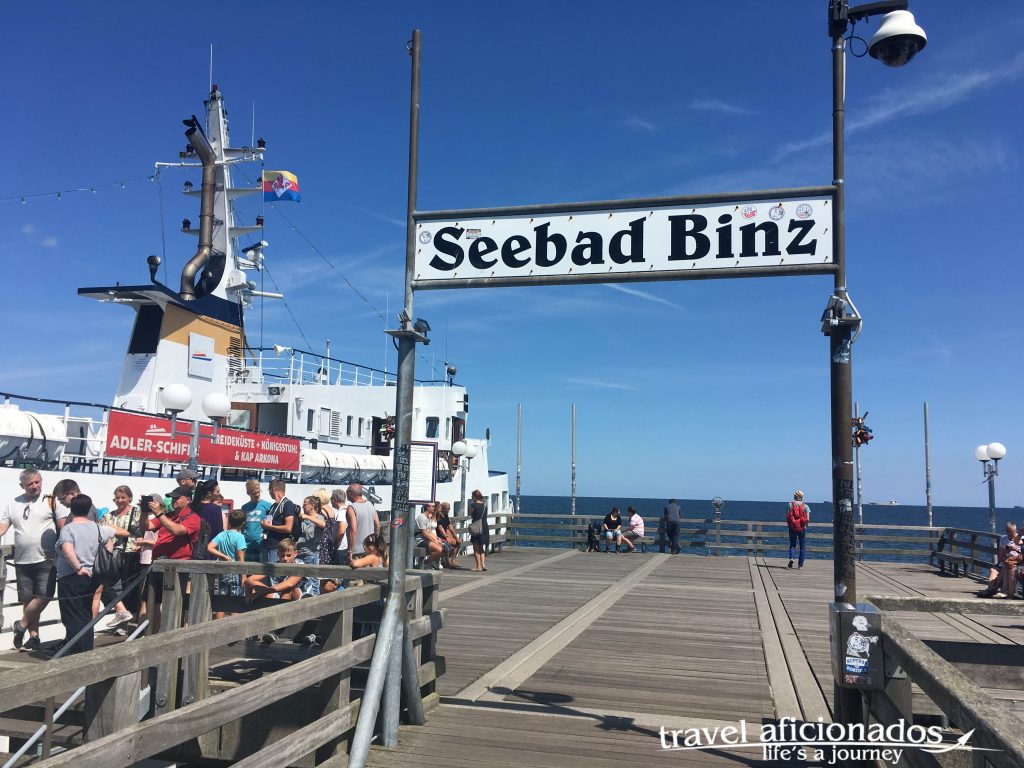
Arriving in Binz by boat
Binz – short history crash course
Tourism in Binz started in the late 19th century with a few splendid villas built to accommodate tourists. Binz was not the first seaside resort on Rügen, the first hotels were built in Putbus, but they lacked a nice beach. So the early tourists were taken to Binz by horse carriage to enjoy a sandy beach. The two-hour trip was strenuous and as a result some entrepreneur had villas built on the beachfront in Binz, then a tiny village.
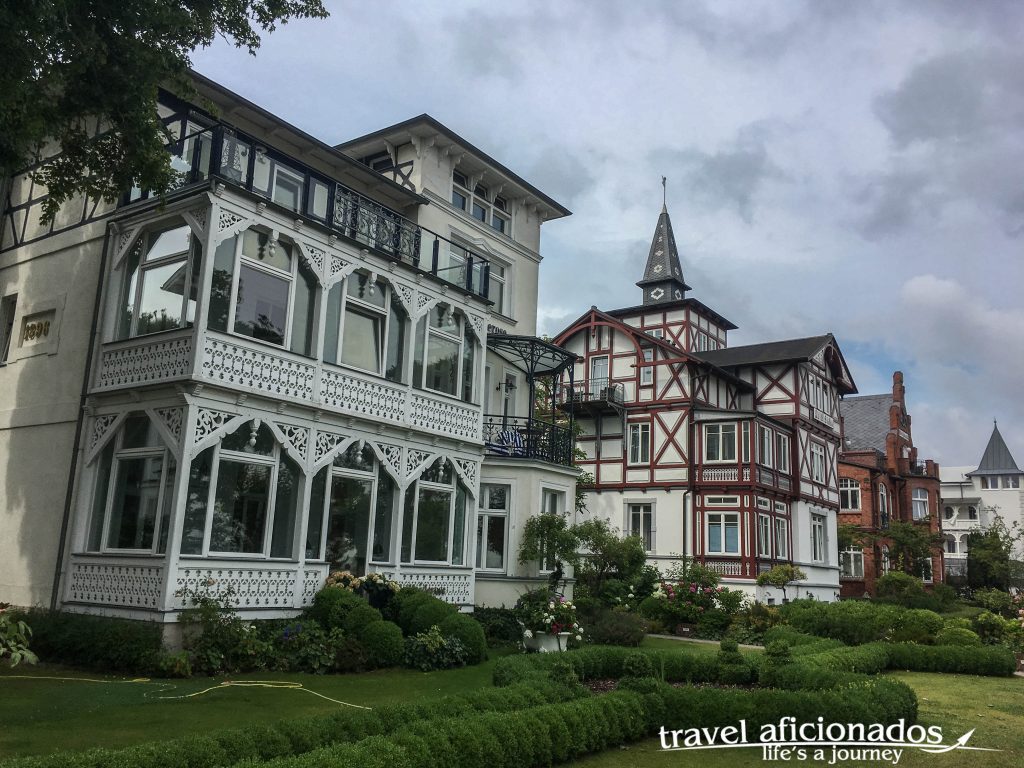
Old villas on the beachfront – now they turned into gold
And those villas along the beachfront are now the pride of Binz, there is even a name for them “Bäderarchitektur”. The architecture of these villas, verandas and little towers that serve no purpose but draw attention, make Binz very unique. Especially when you arrive from the sea, the huge hotel right at the pier is a true sight.
Each villa has its own unique history and luckily a local couple offers walking tours. It was fascinating to listen to the stories that combined history politics and family sagas. The earliest villas were naturally built right along the beach. Each has its own name, like Baltik, Strandvogel and to this day an address in central Binz means little to an elderly local. It is the name of the villas that serves as direction.
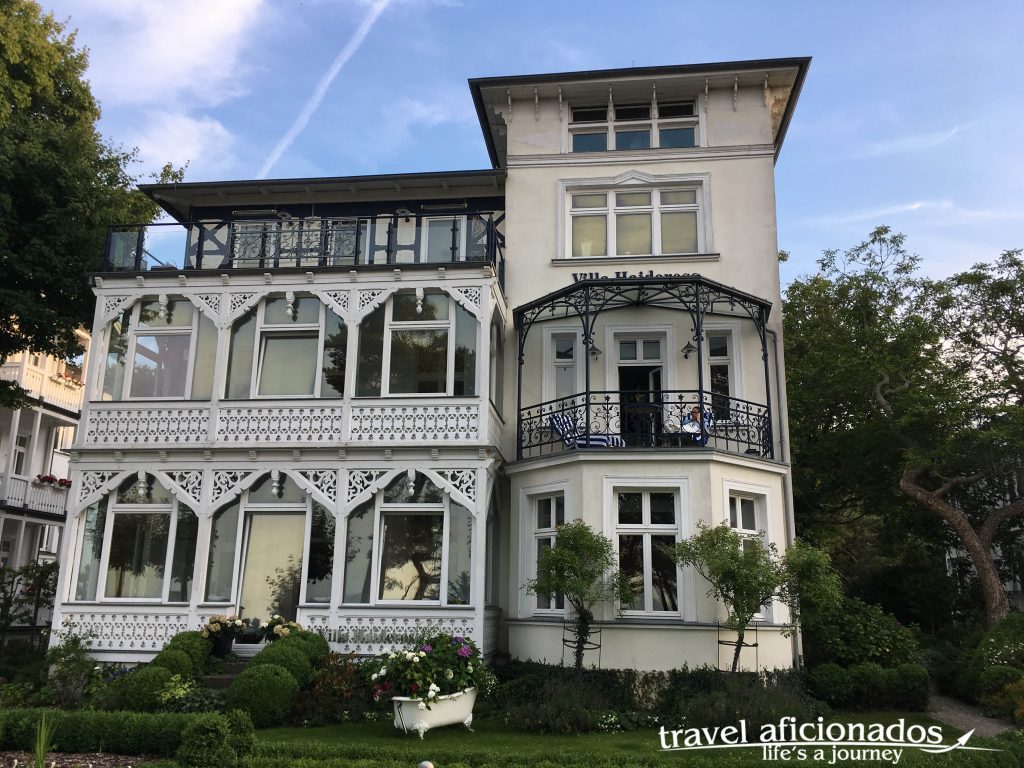
Binz – Villa Heiderose
WWII brought the flourishing business to a stop. The villas accommodated refugees or military personal and some owners fled from the advancing Russian army. In the 1950th the government of the GDR nationalized the villas and turned them into apartments. Only after the “Wende” some of the former owners were found and only a few motivated to invest in the run-down buildings. A smart move. Now these prime properties facing the seafront are pure gold. An apartment in those villas nowadays costs a mind-boggling € 17.000 m2. The price per m2 has risen by € 1000 every year since 2010. Not only locals roll their eyes at such ludicrous prices.
The dimensions tourism has taken worries lots of the residents of Binz. In 2017 over 1,5 millions visitors arrived in Binz, a town of 5000 residents. I was struck by the nasses that moved along the pedestrian zone leading to the pier. This stretch is lined with shops and restaurants, it could have been anywhere in the world.
Beach bums
Sunbathing for me personally is an act truly unthinkable, has always been, but I had dreamt of making myself comfortable in one of those wicker chairs and read a book. Well, I found them actually very uncomfortable. The crowded beach in Binz was the living proof that not everybody feels like me. The beach resembles an endless giant sickle that runs from Binz all the way up to the newly built harbor in Mukran.
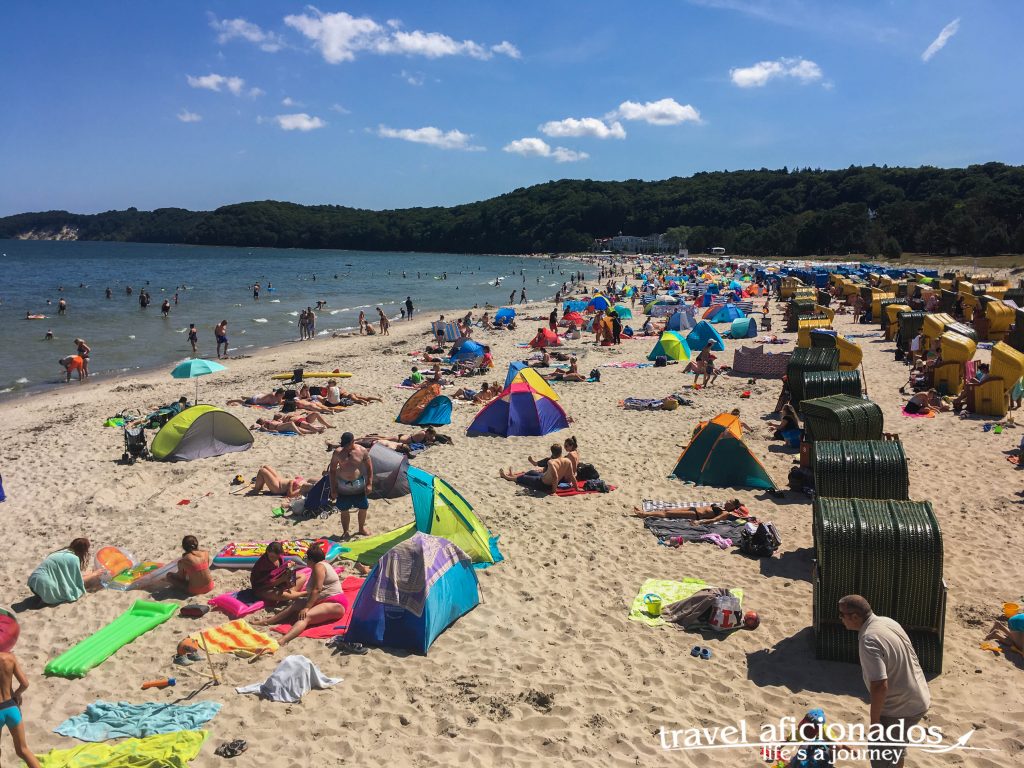
Beach around Binz
July 2018 was extremely sunny and warm and the wide beach was covered with wicker chairs, tents and devices to provide shelter from the wind, except there was no wind. In those two weeks I spend at the Ostsee it was almost ghostly quiet, not even a breeze.
Tourists are almost exclusively Germany, families with children or elderly people. This is a children’s paradise, building sandcastles, floating on plastic crocodiles, splashing water at siblings and munching French fries or ice-cream from the nearby food-truck.
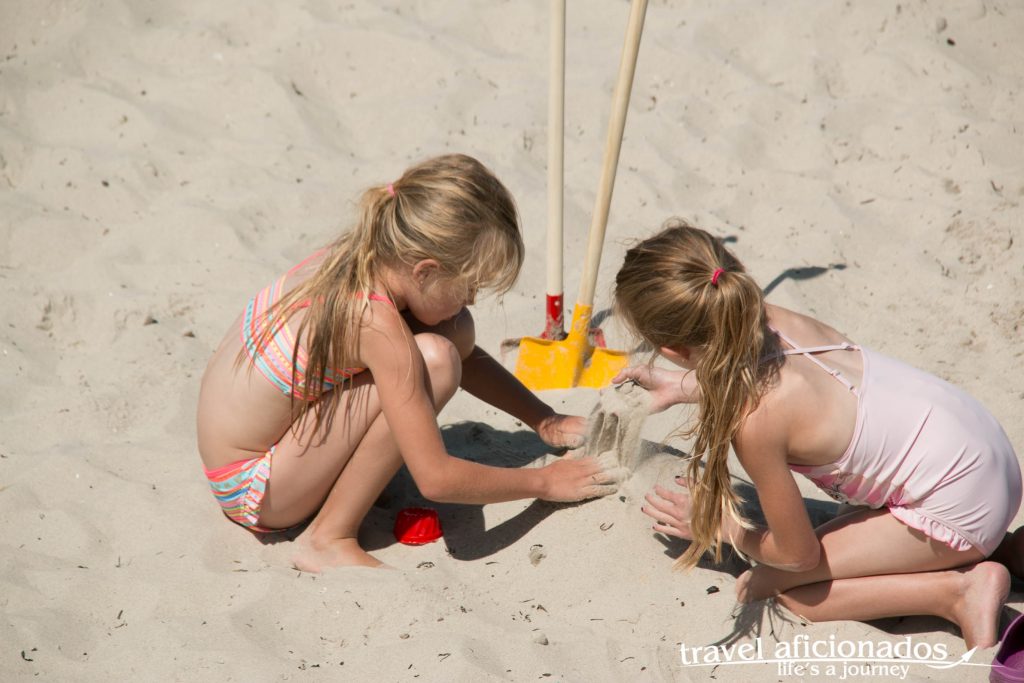
Beach life in Binz
For me beaches are made for walking and that is what I did in the evening when most of the people were gone. The sun did not set before 10:30 pm so there was plenty of time when I had the beach for myself.
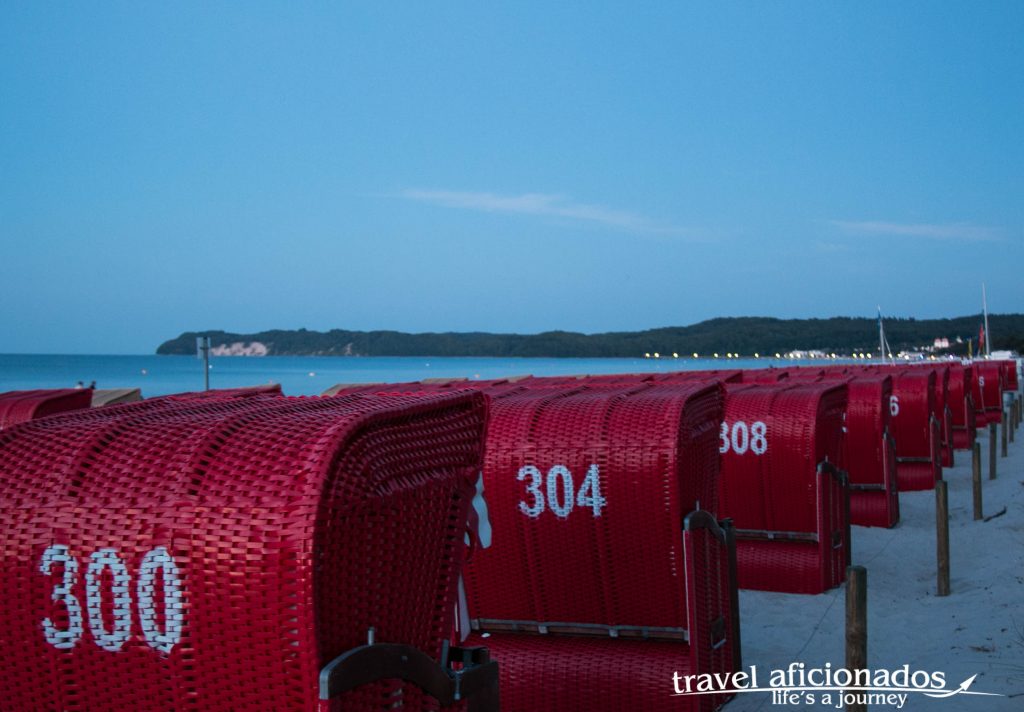
Endless evening walks along the beach
Prora – NS seaside resort gone investorway
How did a megalomaniac NS project turn into a real estate project? The NS organization “Kraft durch Freude” had this gigantic resort built here right on the beach between 1936-1939. The eight concrete blocks stretch over 4,7km along the ocean front and were meant to host 20.000 vacationers, workers of the German Democratic Republic. But Prora was never used as a holiday resort, in 1939 once the war started the project was stopped. During the war it served mainly military purposes and to shelter refugees. Until 1991 is was only used by the military and was off-limit for civilians. After the Wende the big question was what to do with this gigantic complex that was granted monument protection. In 2013, investors bought the area, paying € 370.000 for each block (500m lang). In 2018 this is exactly the price for ONE 70m2 apartment in one of the “renovated” blocks.
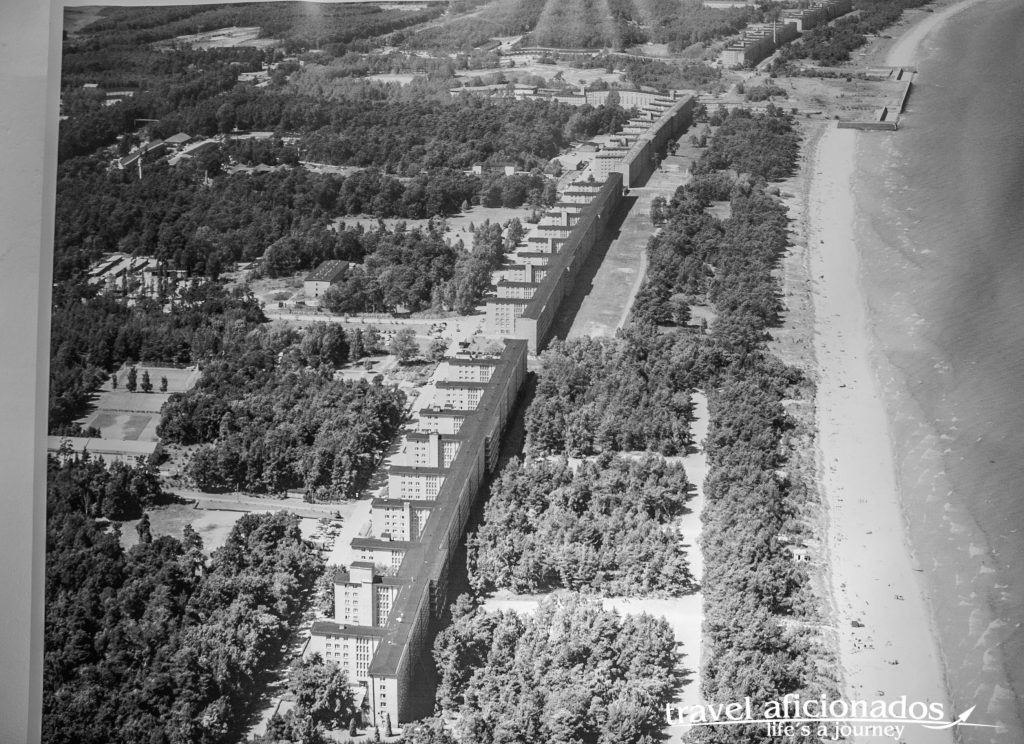
historic photo of Prora – it only Shows half of the complex
This kind of speculation has created a lot of bad feelings among the locals. Especially since the investor who bought the southern section rents the flats for € 10 per m2, for expensive Rügen a fair price. One block of the southern section was newly renovated when I visited and it was very strange to watch people sitting on the tiny balconies, a bit spooky. I wondered how it feels to be constantly observed by visitors in emotional uproar about this project.
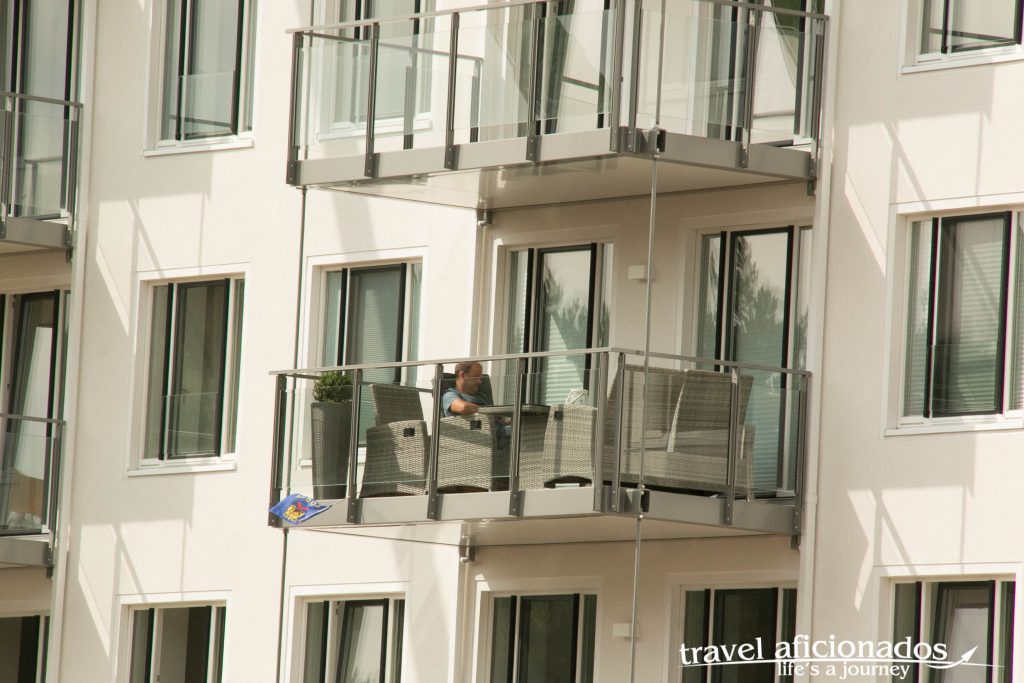
Renovated block of Prora, expensive apartments
One block was turned into a very popular hostel, when I visited there was an international youth event and the place and the campsite was jam-packed with young people.
Despite its enormous dimension the building can hardly be seen from the ocean nowadays. Over the years nature has taken over, now a little forest separates the beach from the row of endless long concretes blocks.
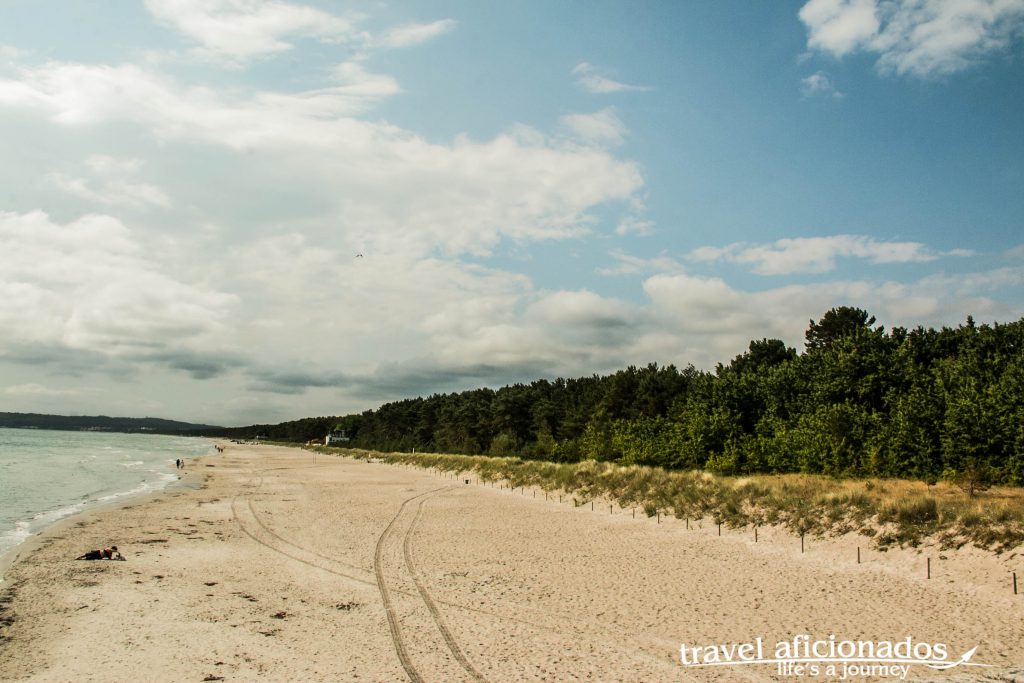
Now a forest separates the many blocks from the beach, nature has taken over
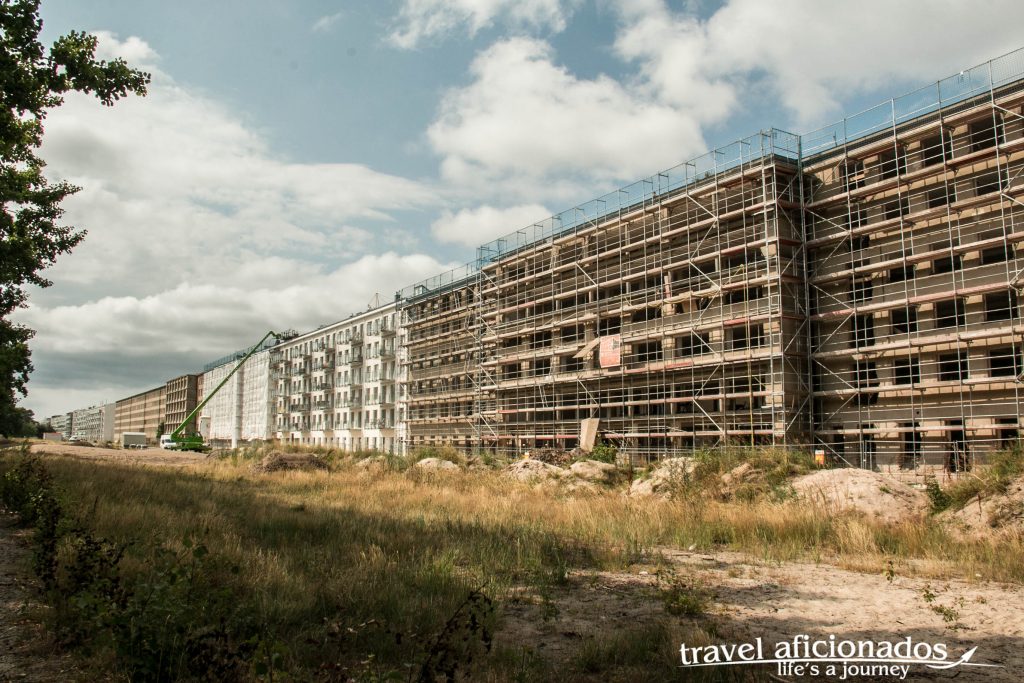
Block after block Streiches along the beach – 4,7km long in total
To grasp the dimensions: I had to take two wide-angle photos to cover only the southern section.
I spent half a day walking around the area, in the museum and also joined an extremely informative tour.
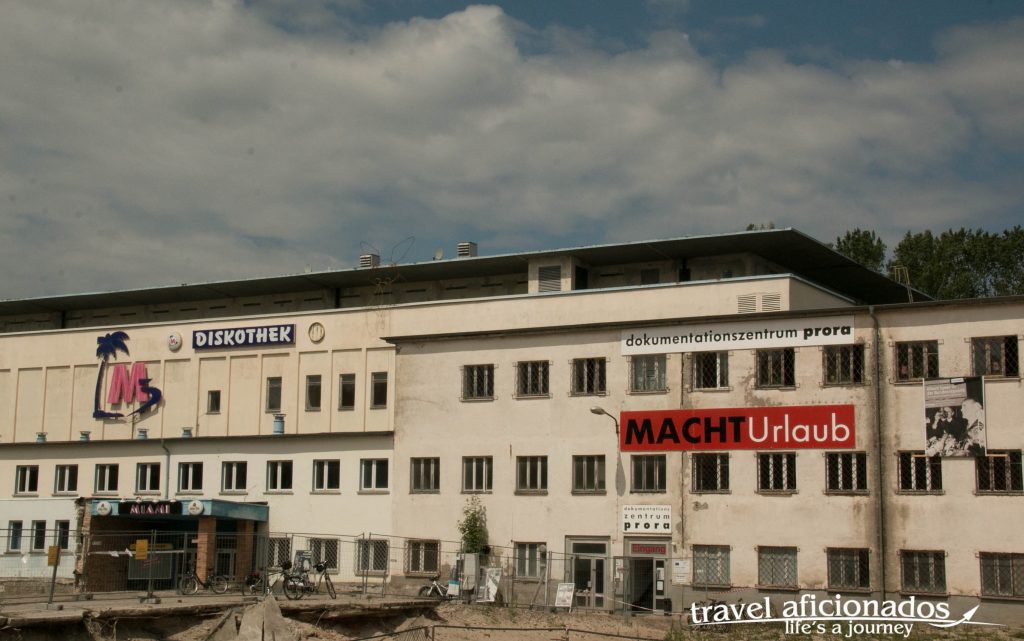
Museum on Prora
The museum is very very informative and the staff highly engaged and motivated although the centers survived solely from the tickets sold and until recently did not even know whether the center would survive due to the new ownership. I would rank this visit among my top experience on this holiday, but not everybody is a history nerd.
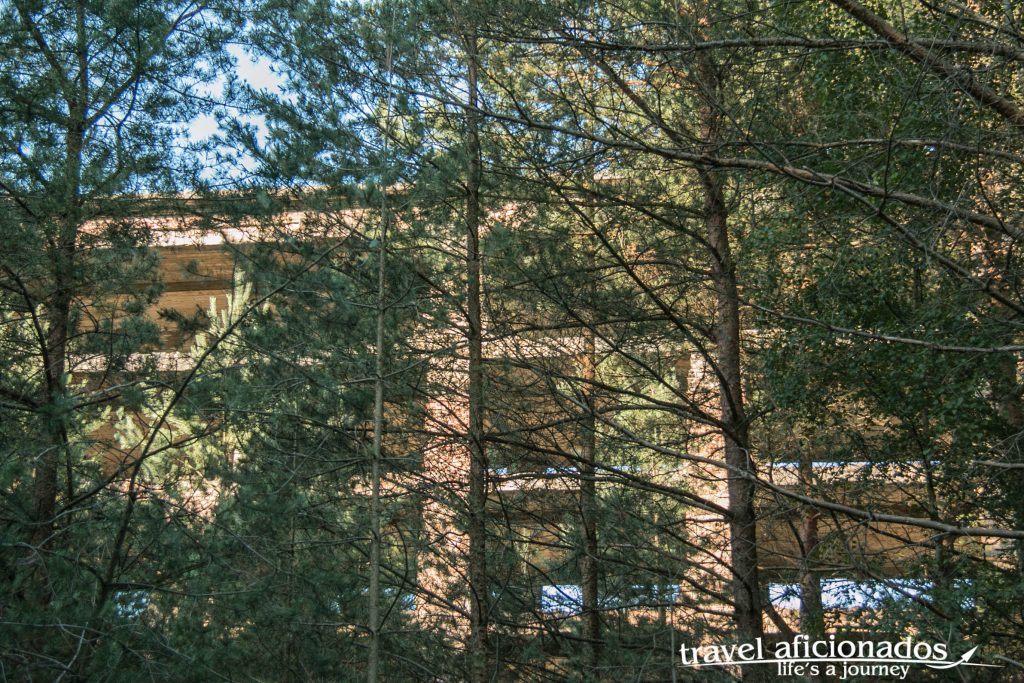
Some buildings were never finished
White Cliffs – Jasmund Nationalpark
As soon as our boat pulled out of Sassnitz harbor, the White Cliffs appeared around the corner. In 1989, the Jasmund Pensinsular was turned into a national park, right before the Honnecker Regime collapsed. This boat trip was my favorite excursion on Rügen. The boat left from Binz and briefly stopped in Sassnitz, with is endless mole that protects this once very important harbor. At times long gone by, here trains were loaded onto ferries. The most famous transit of Lenin in a sealed train passed through Sassnitz.
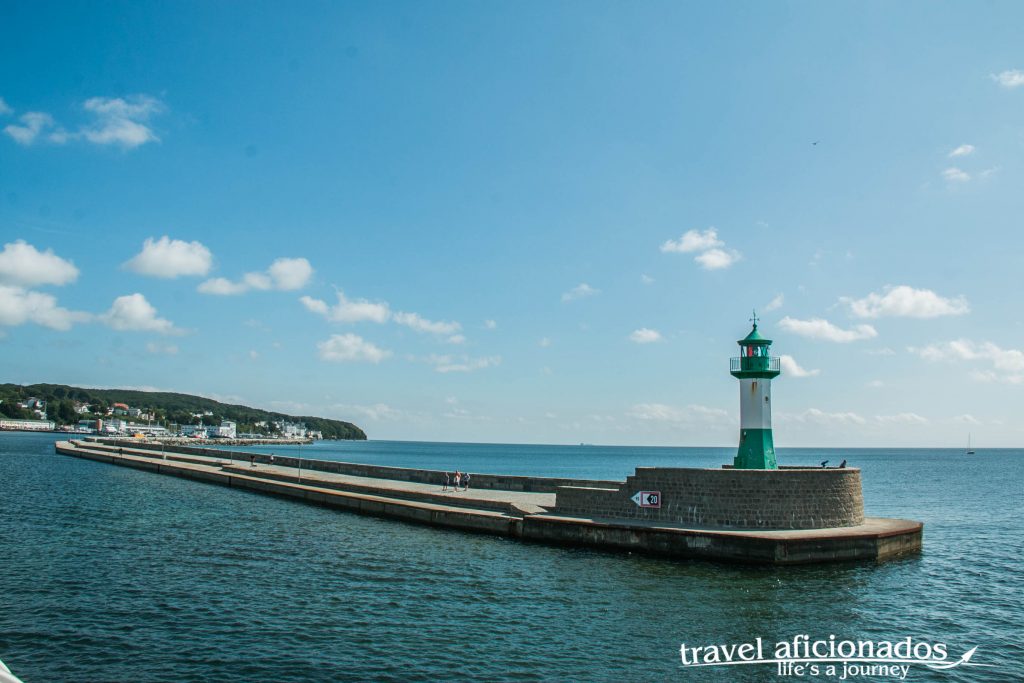
Sassnitz harbour, where the most famous transit of Lenin in a sealed train passed through
The boat sailed as far as “Königsstuhl”, a gigantic cliff that is now crowned by a very popular visitor platform, 300.000 people visited last year. Locals told me the platform was very controversial since many feared it may harm the cliff, especially after a huge cliff had broken off a few years before and is gone forever.
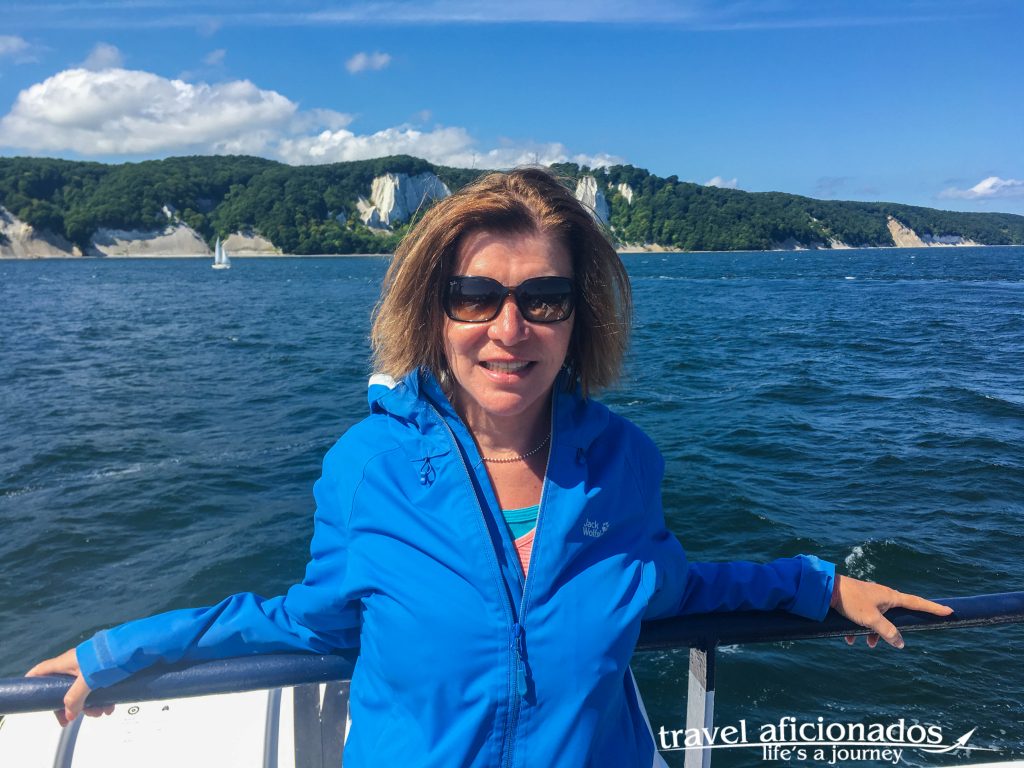
White Cliffs in Jasmund National Park, founded 1989, Königstuhl in the background

White Cliffs in Jasmund National Park, founded 1989
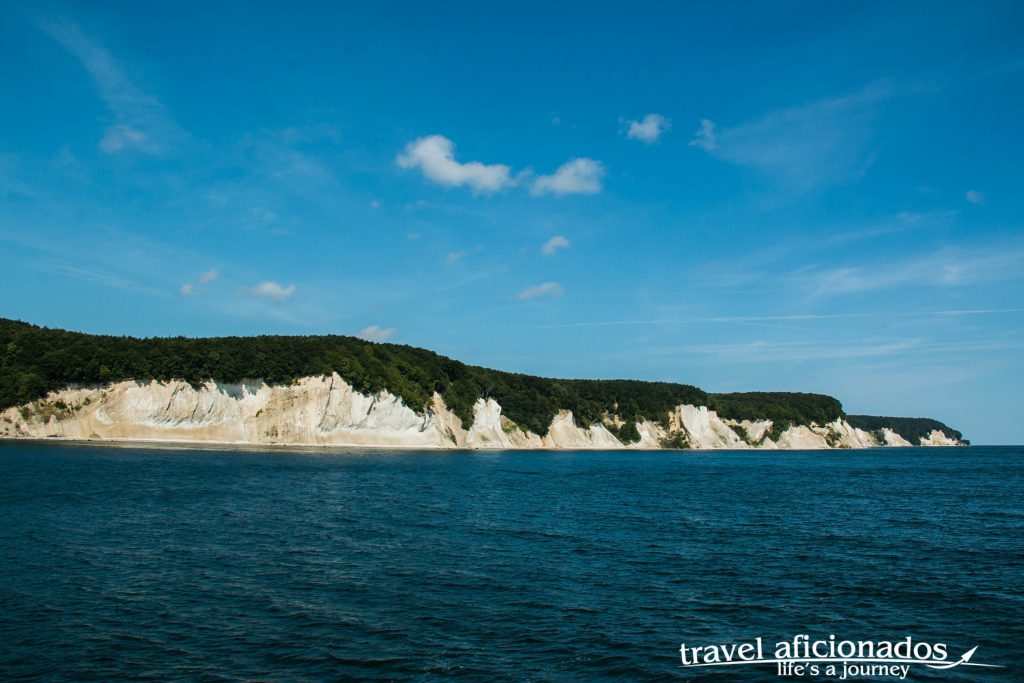
White Cliffs in Jasmund National Park, founded 1989
Hiddensee – dat söte Länneken
Hiddensee island, the sweet land, as locals call it in Plattdeutsch, is unique. The thatched white houses, the lighthouse, the reed-seamed bodden, the gently rolling fields in the north create a great flair. What struck me immediately was how quiet it was. All I could hear were birds, once in a while the cluttering of hooves. What the absence of cars can do. Even the people spoke in a hushed voice as if not to disturb this paradise-like ambience.
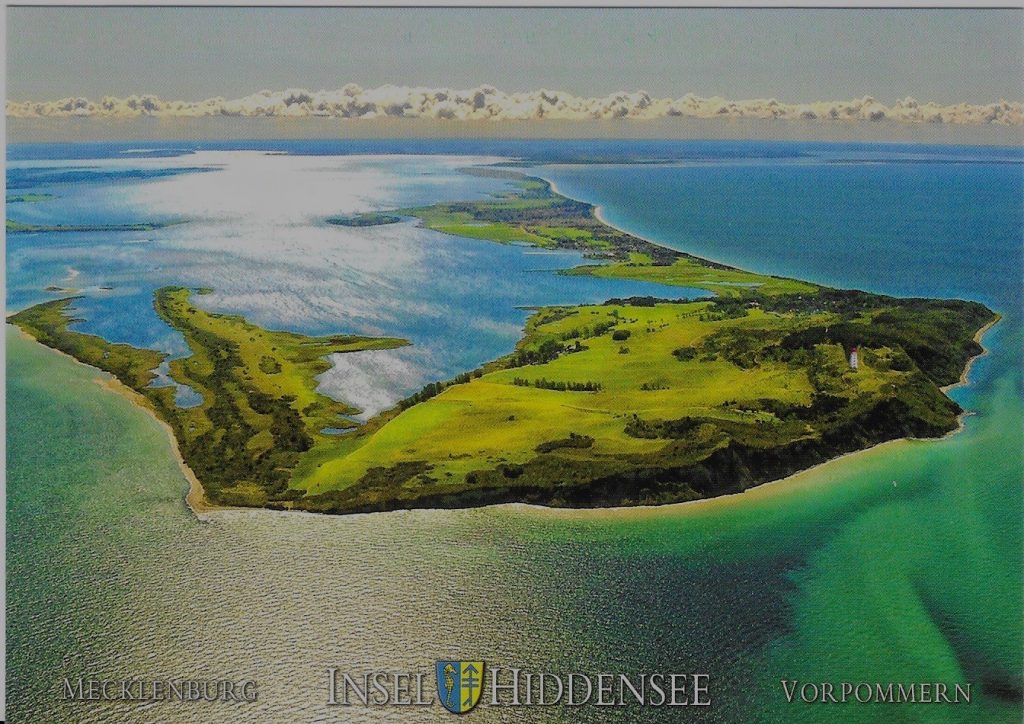
Map of Hiddensee Island – looking south
Hiddensee island is often called Rügen’s little sister, which does not do it justice. Alright they are close, but otherwise they have not much in common. No crowds, no fast-food stalls, it is simply calm, Even the air smelled differently when the ferry from Stralsund made its first stop in Vitte. I could not define it, but it felt good.
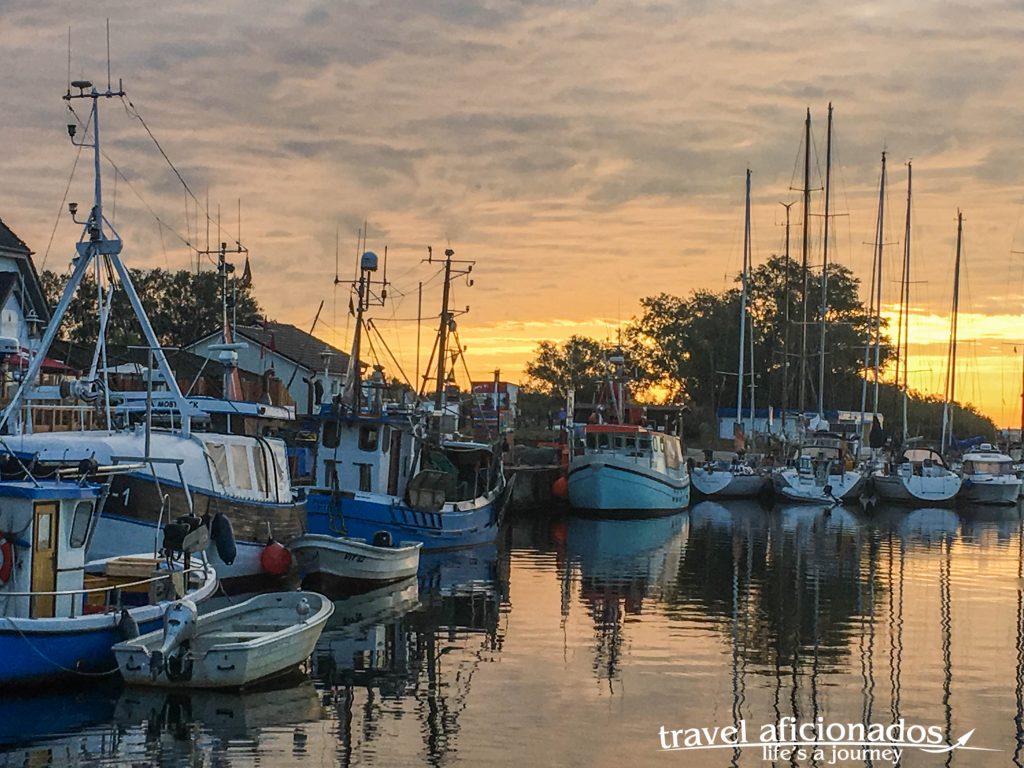
Hiddensee – port
When I got off the boat in the village of Kloster I watched people grabbing little carts that were parked in the harbor. Each had the name of a hotel on it. I decided against throwing my trolley into one that said Hotel Enddorn, but I wanted to get a real feel for the distance and dragged my trolley 2km on cobble stone roads to the even smaller village of Grieben that basically consists of a few houses.
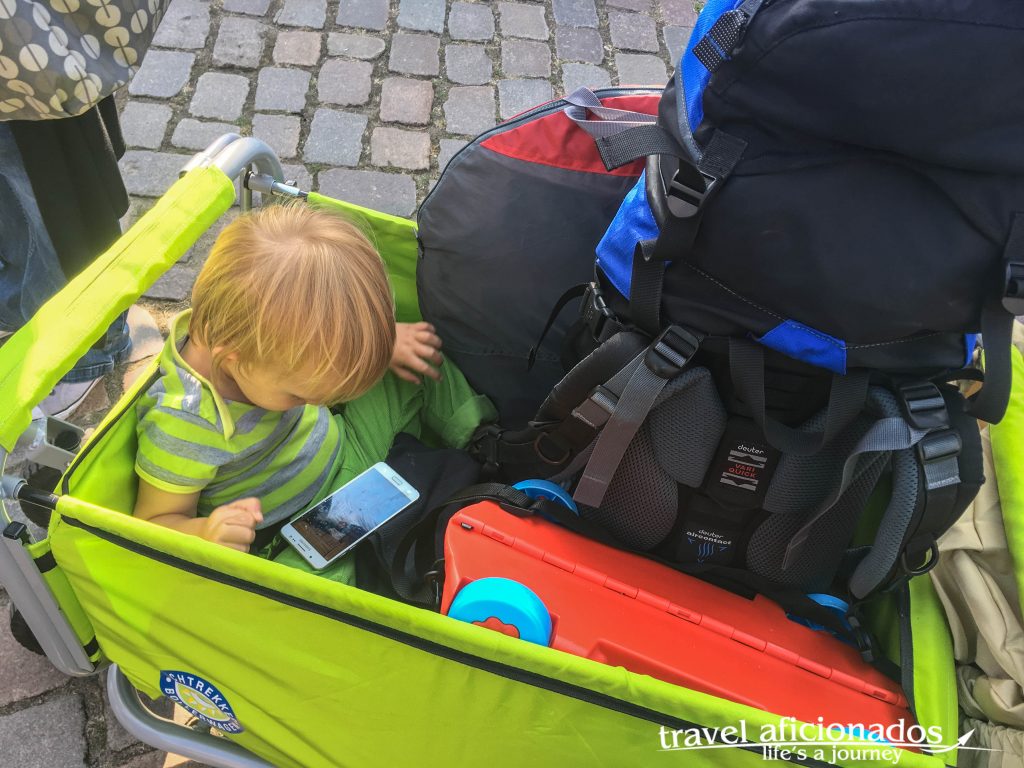
Trolleys transport everything, luggage, to kids, garbage
At Hotel Enddorn, the best place on Hiddensee, I stayed. Lucky me, I had no reservation, but lots and lots of phone calls granted me with three nights on this gorgeous island during the peak time of the tourist season. My large airy room looked onto a field where deer grazed early in the morning. I could see as far as the bodden so unique for the Baltic Sea. These are lagoon-like bodies of salty water. I slept with the door open not to miss any to these wonders.
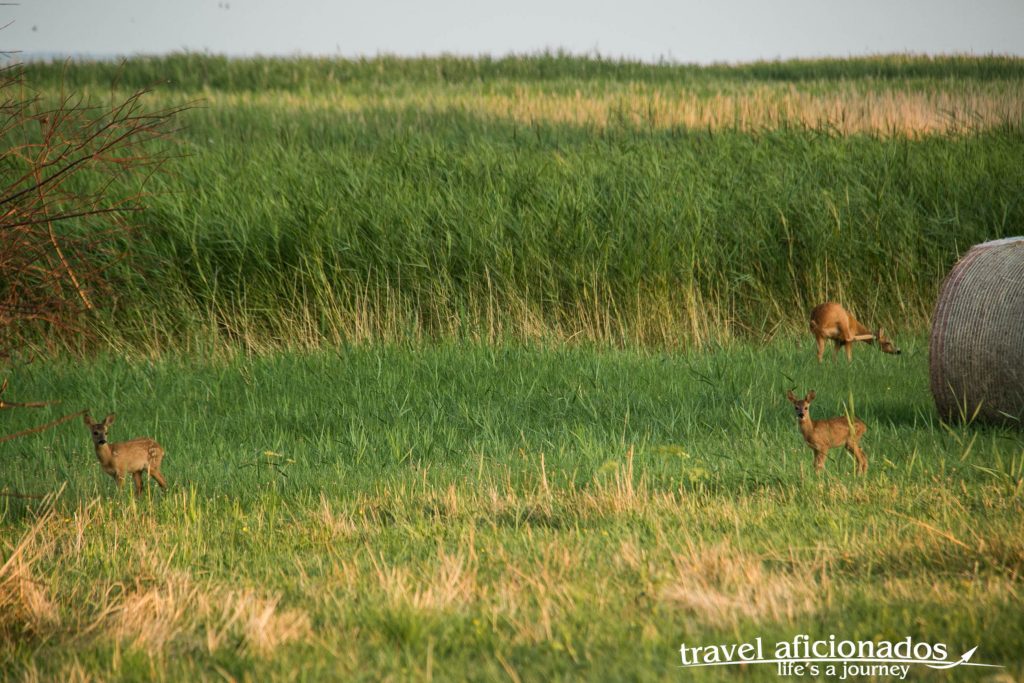
View from my room at Hotel Enddorn
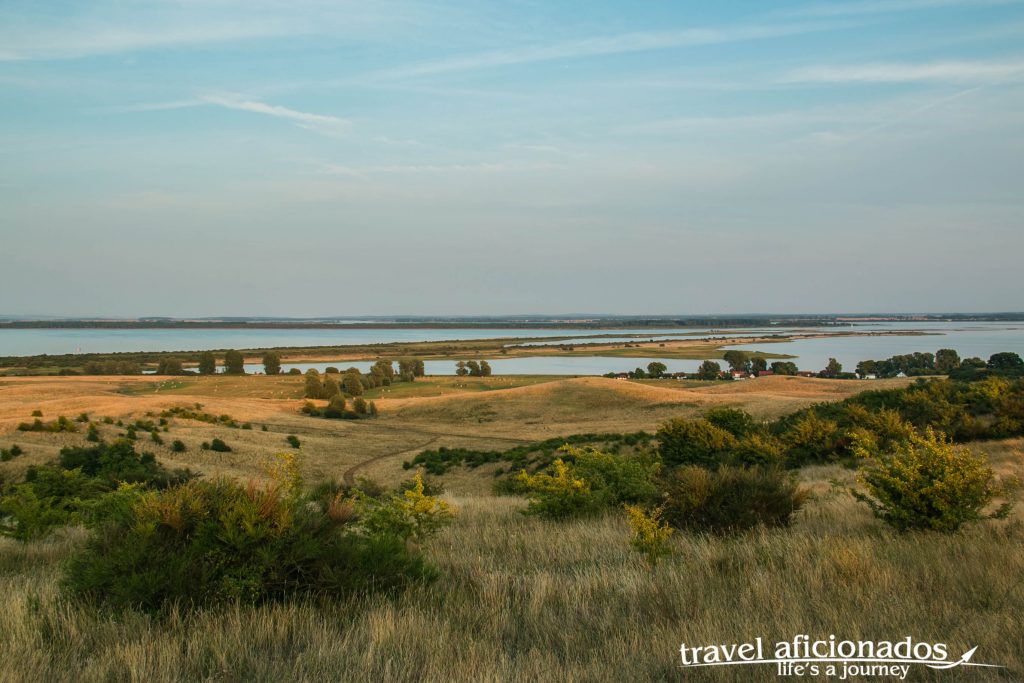
View from my room at Hotel Enddorn
This is bikes’ territory. Cars are off-limit (I saw a tractor once, and there is a e-bus once a day) and the 14km longish island is flat, so this is the main mode of transport. Others are horse carriages and a few golf-carts, run on batteries. People come here for exactly that, to enjoy this car-free environment, where the kids roam around freely, the garbage is wheeled away on cargo-bikes and the beaches are not crowded.
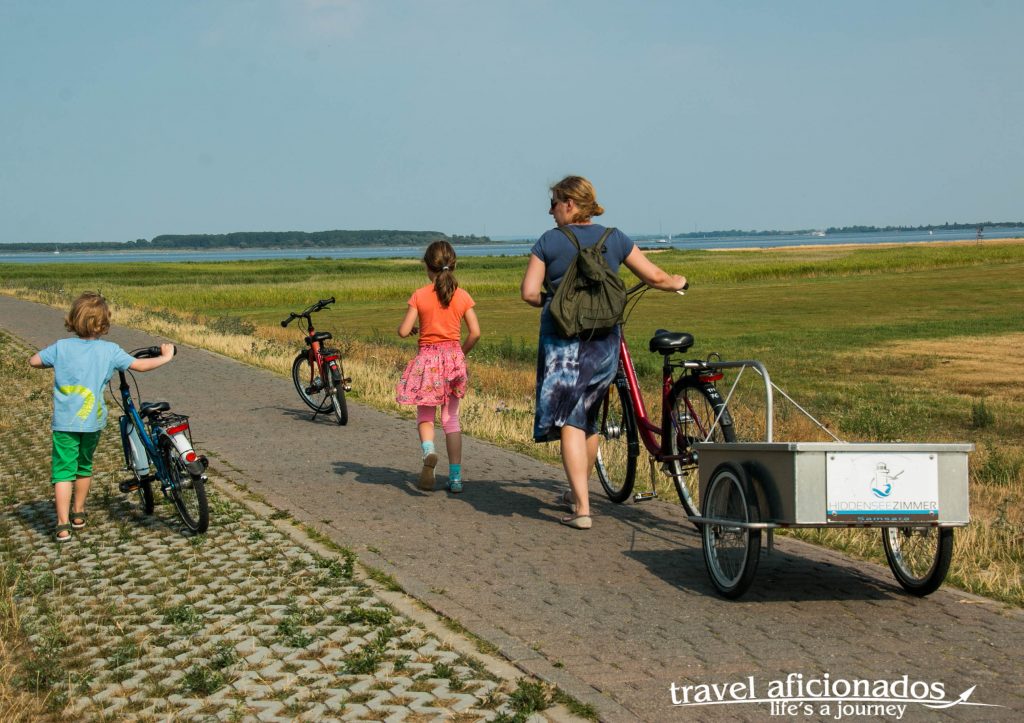
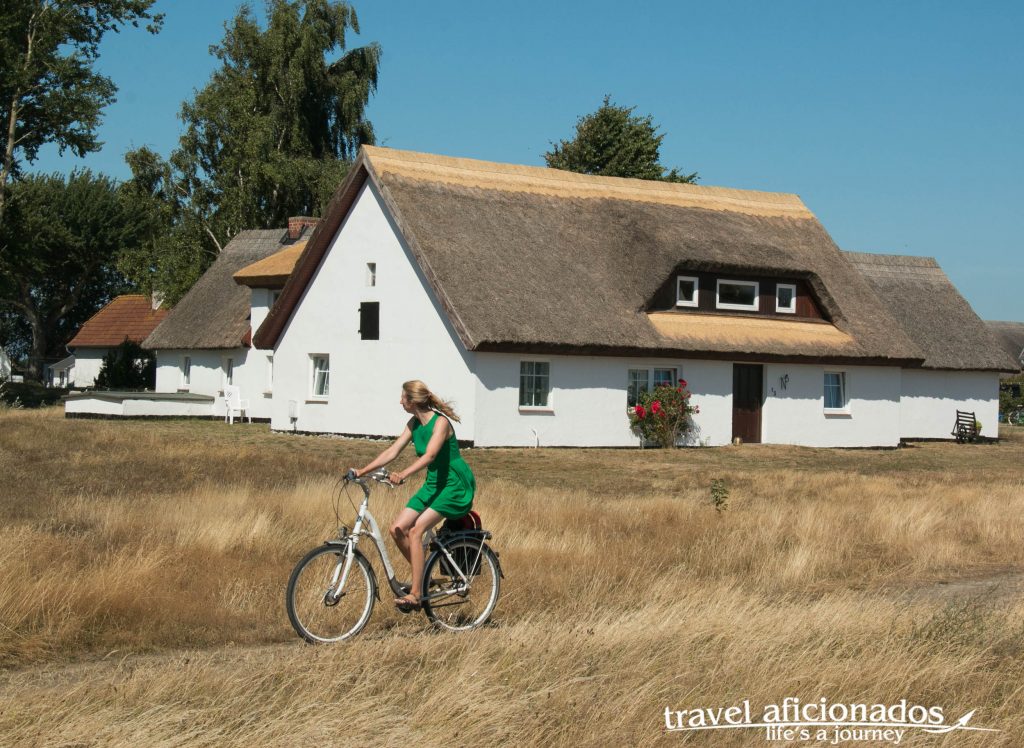
Typical architecture, typical form of mobility
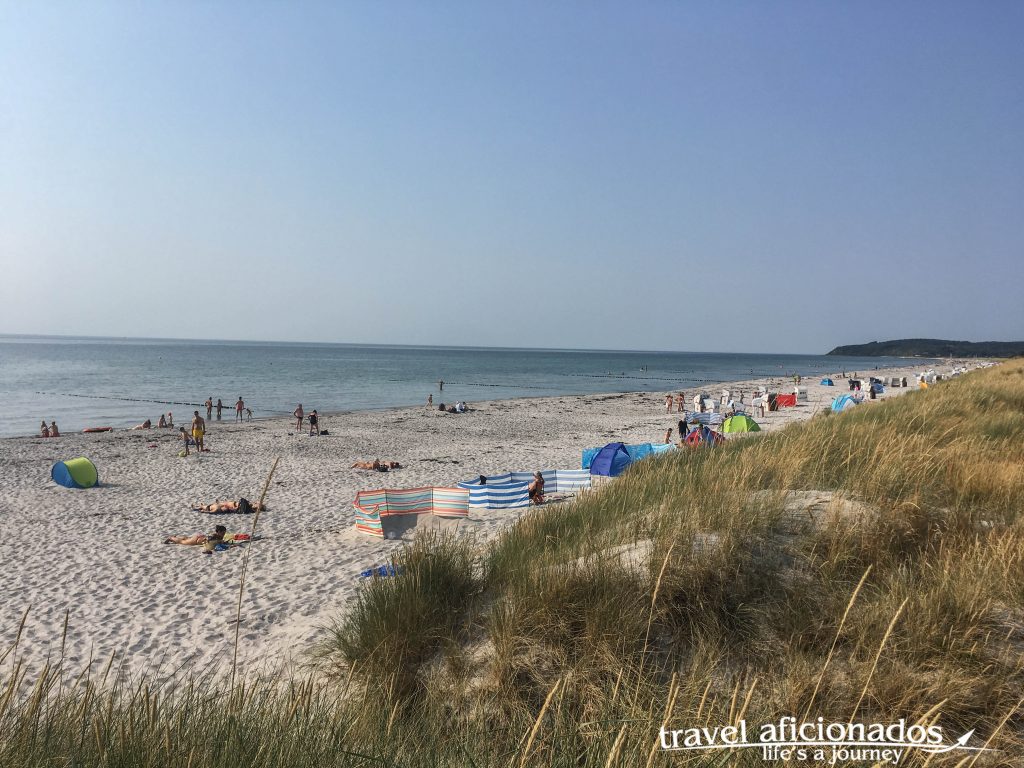
Beaches on Hiddensee
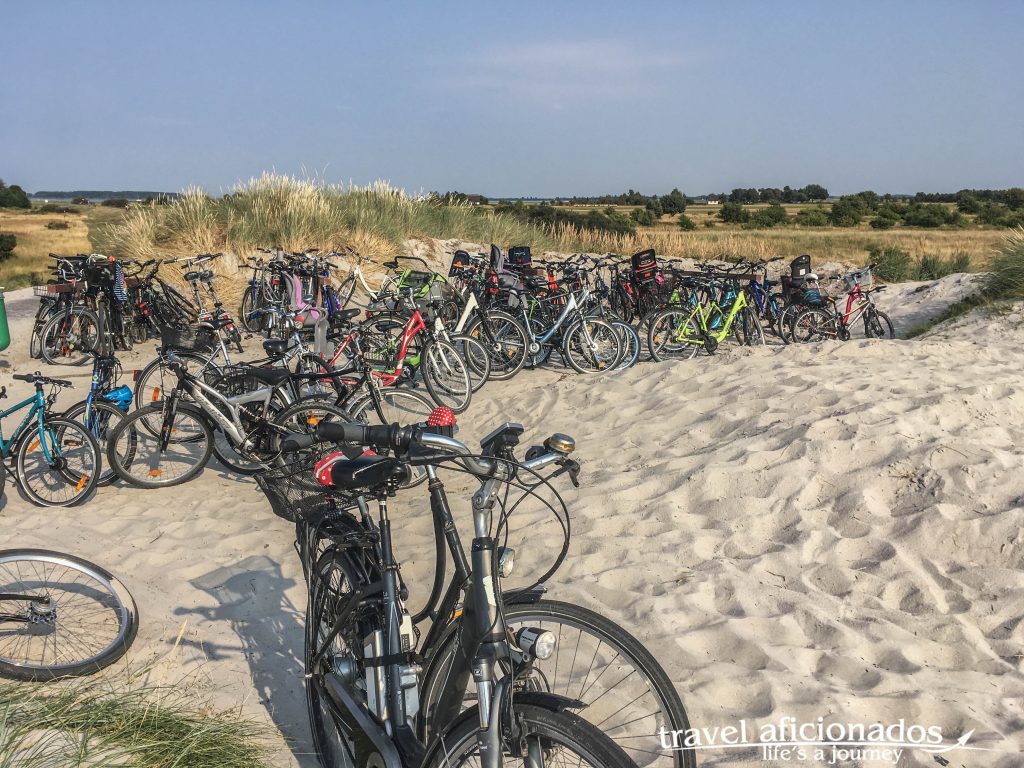
Riding to beaches of Hiddensee
Artists first made the island of Hiddensee famous. Actress Asta Nielsen, painter /sculptor Käthe Kollwitz and writer Gerhart Hauptmann all stayed there. Today, Hauptmann’s former home is open to the public and his grave can be visited at the local cemetery. I love roaming around cemeteries, no matter where in the world, I surely I discovered the grave of another special person, a member of the resistance group “Weiße Rose”. The withered tombstone says Sabine Hirschberg (1921-1943), she committed suicide in 1943 and was buried on Hiddensee where her parents had a summer home that she loved.
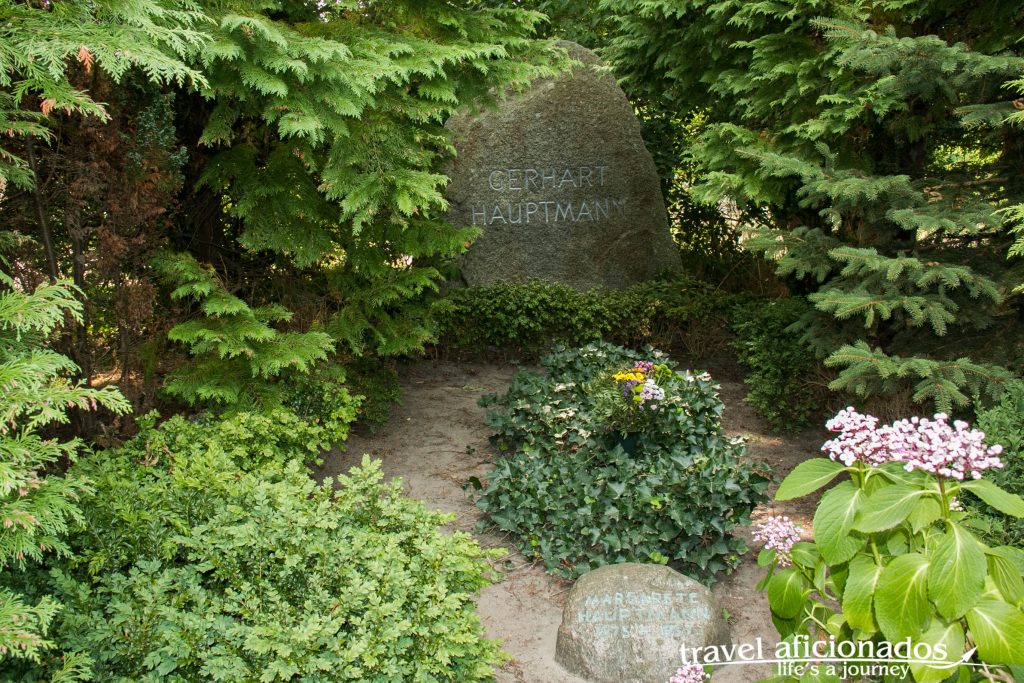
Grave of writer Gerhard Hauptmann
My last evening, I spent at the foot of the lighthouse called “Dornbusch”. It sits on a hill, with 98m it is highest point on the island. To watch the set on this precious place was truly emotional. Till the 90s, a real person tended the lighthouse, which is now controlled by a computer system from far away Stralsund.
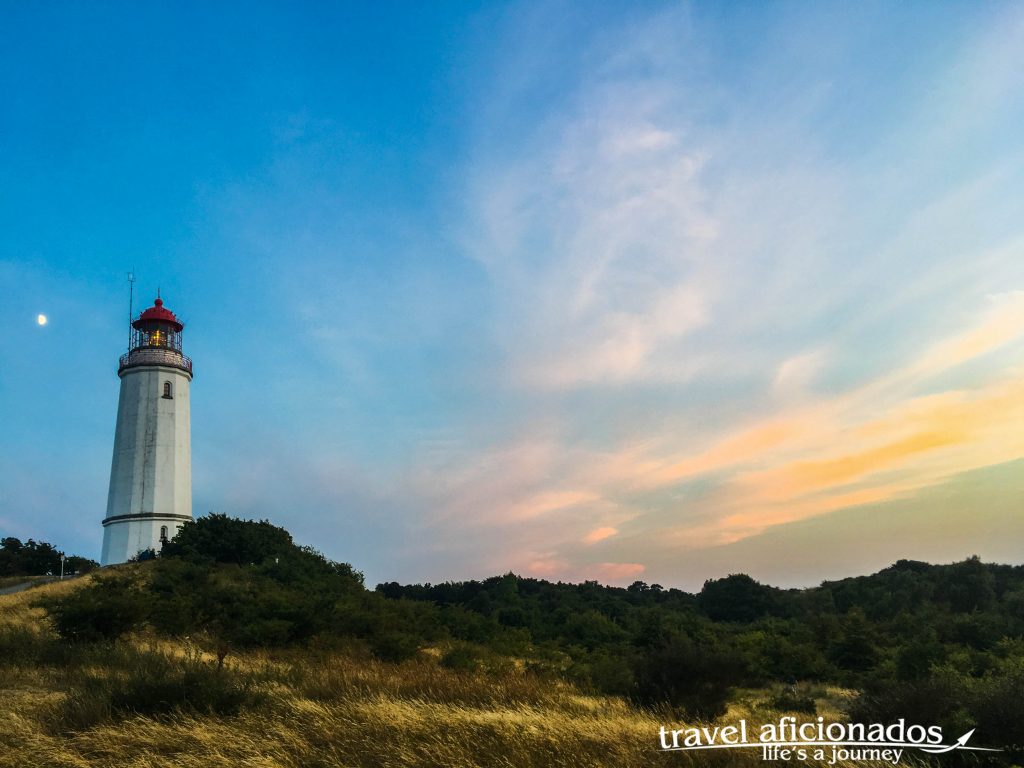
Lighthouse “Dornbusch”
Lütt Partie – the story of Hiddensee’s fishermen
Again, just the very name got me interested, besides I cannot easily pass a museum, especially if it is as unusual as this one. An old shed turned into museum portrays the hard and dangerous life of fishermen on the island. And, even better, it was their initiative to create this hands-on display of various equipment, old photos showing the work of those tough men. The sad story nowadays only 20 full-time fishermen live on Hiddensee, it is a tough life and with tourism offering better jobs, few are still ready to do this hard job with little income.
I had biked there and was the only visitor for a while having the full attention of a former fishermen who explained very tool, photo and offered great stories, like how ice-fishing worked. The upper floor is just nets, nothing else and I learned that a net is not simply a net, but each serves a different purpose.
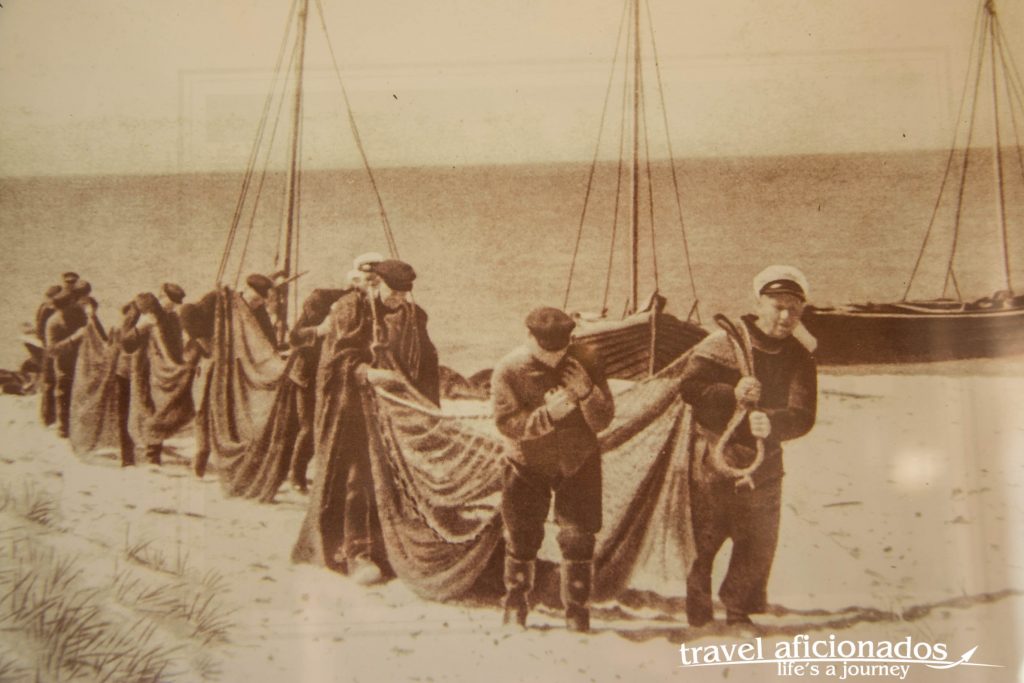
Historic photos taken from photos in museum
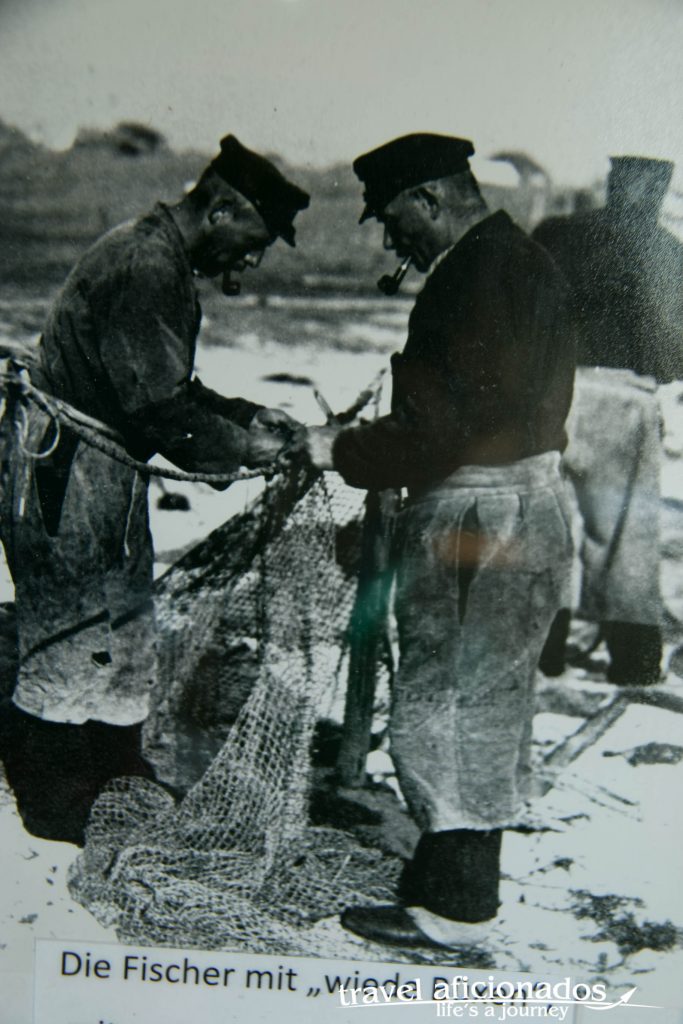
Historic photos
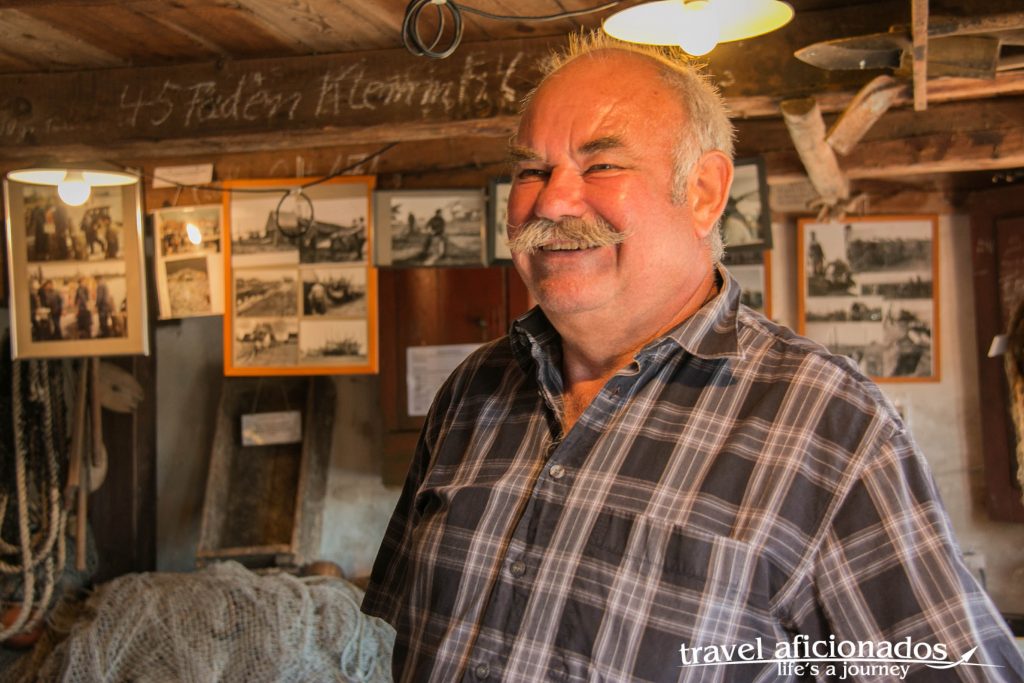
My personal guide through the museum, a former fisherman
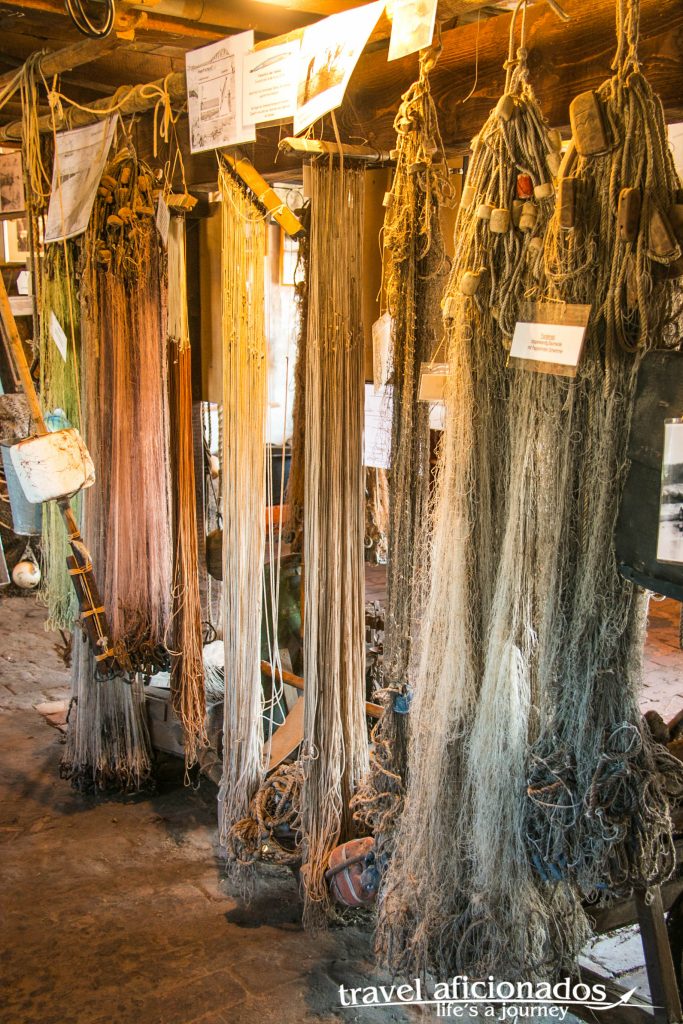
A room full of nets
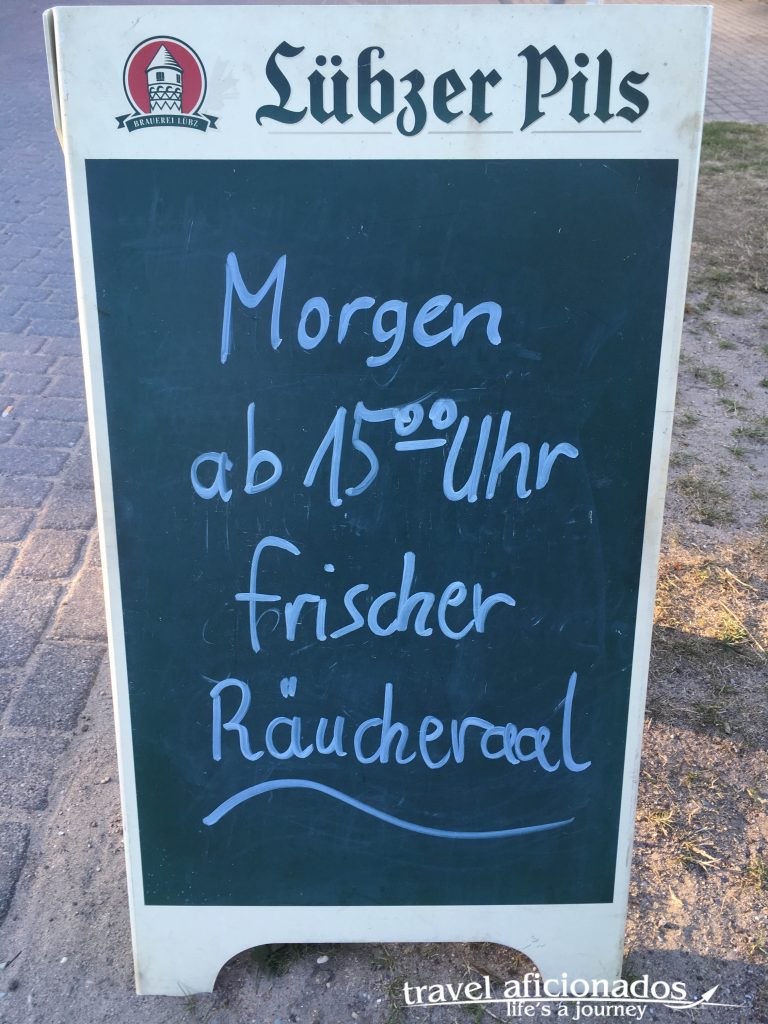
Probably a menu not seen very often in the world
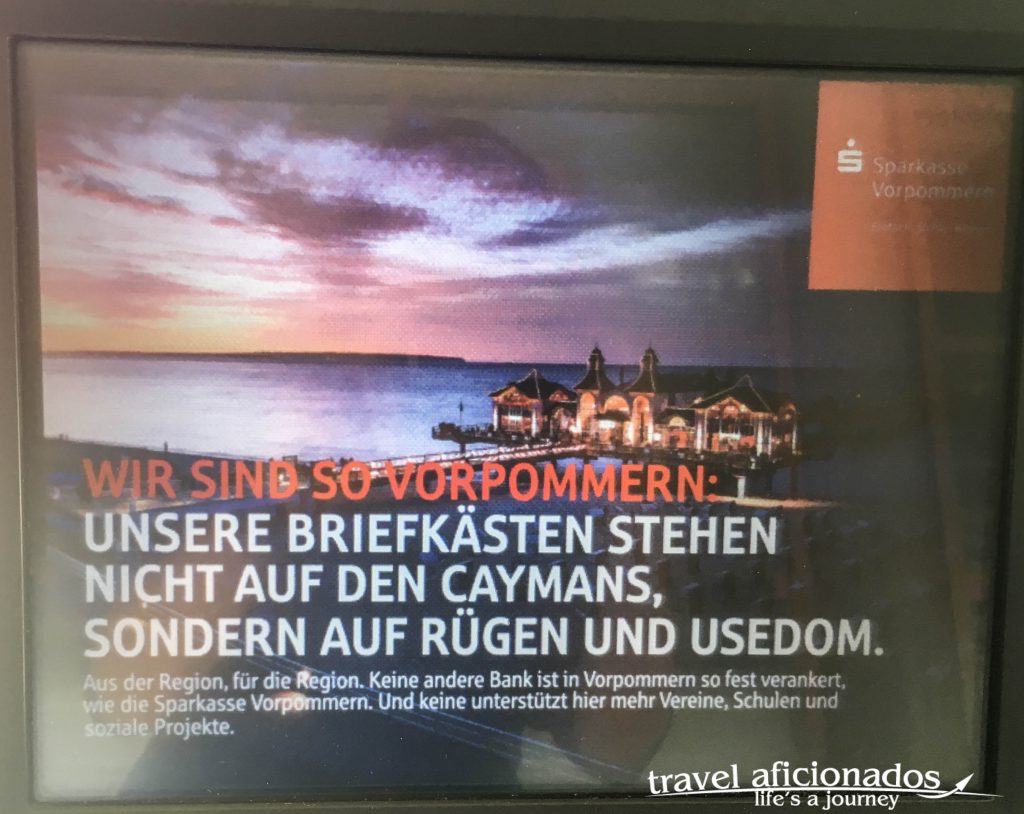
never think that those people in northern Germany lack humour
Talking about hardship: I had hoped to escape the super-hot temperatures that turned Austria in an oven that summer. I figured going north was the solution. Ironically, only to find myself in an oven-like climate, completely unknown in the region.
On the way home I stopped in Berlin for a day and enjoyed an evening in a beer garden, more was not possible due to the heat.



















































No comments yet.